Europe
Europe is a continent located entirely in the Northern Hemisphere and mostly in the Eastern Hemisphere. It comprises the westernmost part of Eurasia and is bordered by the Arctic Ocean to the north, the Atlantic Ocean to the west, the Mediterranean Sea to the south, and Asia to the east. Europe is commonly considered to be separated from Asia by the watershed of the Ural Mountains, the Ural River, the Caspian Sea, the Greater Caucasus, the Black Sea, and the waterways of the Turkish Straits.[9] Although some of this border is over land, Europe is generally accorded the status of a full continent because of its great physical size and the weight of history and tradition.
.svg.png) 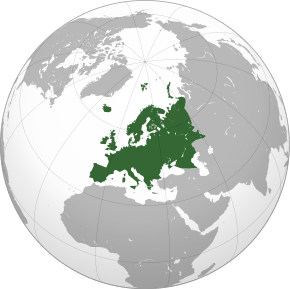 | |
| Area | 10,180,000 km2 (3,930,000 sq mi)[1] (6th)[a] |
|---|---|
| Population | 746,419,440 (2018; 3rd)[2][3] |
| Population density | 72.9/km2 (188/sq mi) (2nd) |
| GDP (PPP) | $29.01 trillion (2019; 2nd)[4] |
| GDP (nominal) | $21.79 trillion (2019; 3rd)[5] |
| GDP per capita | $29,410 (2019; 3rd)[c][6] |
| HDI | |
| Demonym | European |
| Countries | 50 sovereign states 6 with limited recognition |
| Dependencies | 6 dependencies |
| Languages | Most common first languages: |
| Time zones | UTC−1 to UTC+5 |
| Largest cities | Largest urban areas: |
Europe covers about 10,180,000 square kilometres (3,930,000 sq mi), or 2% of the Earth's surface (6.8% of land area), making it the sixth largest continent. Politically, Europe is divided into about fifty sovereign states, of which Russia is the largest and most populous, spanning 39% of the continent and comprising 15% of its population. Europe had a total population of about 741 million (about 11% of the world population) as of 2018.[2][3] The European climate is largely affected by warm Atlantic currents that temper winters and summers on much of the continent, even at latitudes along which the climate in Asia and North America is severe. Further from the sea, seasonal differences are more noticeable than close to the coast.
Europe, in particular ancient Greece and ancient Rome, was the birthplace of Western civilisation.[10][11][12] The fall of the Western Roman Empire in 476 AD and the subsequent Migration Period marked the end of ancient history and the beginning of the Middle Ages. Renaissance humanism, exploration, art and science led to the modern era. Since the Age of Discovery, Europe played a predominant role in global affairs. Between the 16th and 20th centuries, European powers colonized at various times the Americas, almost all of Africa and Oceania and the majority of Asia.
The Age of Enlightenment, the subsequent French Revolution and the Napoleonic Wars shaped the continent culturally, politically and economically from the end of the 17th century until the first half of the 19th century. The Industrial Revolution, which began in Great Britain at the end of the 18th century, gave rise to radical economic, cultural and social change in Western Europe and eventually the wider world. Both world wars took place for the most part in Europe, contributing to a decline in Western European dominance in world affairs by the mid-20th century as the Soviet Union and the United States took prominence.[13] During the Cold War, Europe was divided along the Iron Curtain between NATO in the West and the Warsaw Pact in the East, until the revolutions of 1989 and fall of the Berlin Wall.
In 1949 the Council of Europe was founded with the idea of unifying Europe to achieve common goals. Further European integration by some states led to the formation of the European Union (EU), a separate political entity that lies between a confederation and a federation.[14] The EU originated in Western Europe but has been expanding eastward since the fall of the Soviet Union in 1991. The currency of most countries of the European Union, the euro, is the most commonly used among Europeans; and the EU's Schengen Area abolishes border and immigration controls between most of its member states. There exists a political movement favoring the evolution of the European Union into a single super-federation encompassing much of the continent.
Name
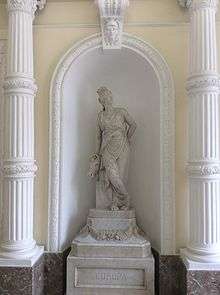
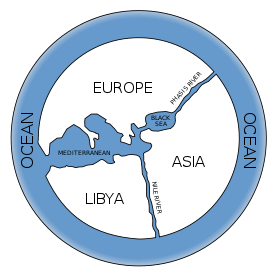
In classical Greek mythology, Europa (Ancient Greek: Εὐρώπη, Eurṓpē) was a Phoenician princess. One view is that her name derives from the ancient Greek elements εὐρύς (eurús), "wide, broad" and ὤψ (ōps, gen. ὠπός, ōpós) "eye, face, countenance", hence their composite Eurṓpē would mean "wide-gazing" or "broad of aspect".[15][16][17] Broad has been an epithet of Earth herself in the reconstructed Proto-Indo-European religion and the poetry devoted to it.[15] An alternative view is that of R.S.P. Beekes who has argued in favor of a Pre-Indo-European origin for the name, explaining that a derivation from ancient Greek eurus would yield a different toponym than Europa. Beekes has located toponyms related to that of Europa in the territory of ancient Greece and localities like that of Europos in ancient Macedonia.[18]
There have been attempts to connect Eurṓpē to a Semitic term for "west", this being either Akkadian erebu meaning "to go down, set" (said of the sun) or Phoenician 'ereb "evening, west",[19] which is at the origin of Arabic Maghreb and Hebrew ma'arav. Michael A. Barry finds the mention of the word Ereb on an Assyrian stele with the meaning of "night, [the country of] sunset", in opposition to Asu "[the country of] sunrise", i.e. Asia. The same naming motive according to "cartographic convention" appears in Greek Ἀνατολή (Anatolḗ "[sun] rise", "east", hence Anatolia).[20] Martin Litchfield West stated that "phonologically, the match between Europa's name and any form of the Semitic word is very poor",[21] while Beekes considers a connection to Semitic languages improbable.[18] Next to these hypotheses there is also a Proto-Indo-European root *h1regʷos, meaning "darkness", which also produced Greek Erebus.
Most major world languages use words derived from Eurṓpē or Europa to refer to the continent. Chinese, for example, uses the word Ōuzhōu (歐洲/欧洲), which is an abbreviation of the transliterated name Ōuluóbā zhōu (歐羅巴洲) (zhōu means "continent"); a similar Chinese-derived term Ōshū (欧州) is also sometimes used in Japanese such as in the Japanese name of the European Union, Ōshū Rengō (欧州連合), despite the katakana Yōroppa (ヨーロッパ) being more commonly used. In some Turkic languages the originally Persian name Frangistan ("land of the Franks") is used casually in referring to much of Europe, besides official names such as Avrupa or Evropa.[22]
Definition
Contemporary definition
Clickable map of Europe, showing one of the most commonly used continental boundaries[23]
Key: blue: states which straddle the border between Europe and Asia;
green: countries not geographically in Europe, but closely associated with the continent
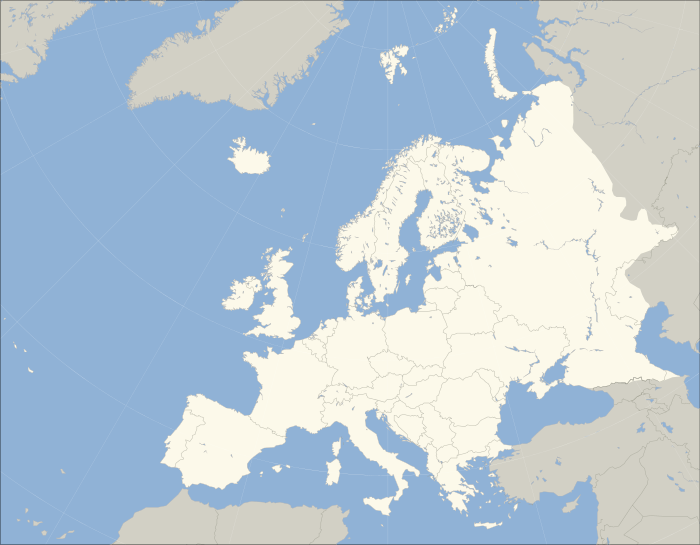
Atlantic
Ocean
The prevalent definition of Europe as a geographical term has been in use since the mid-19th century. Europe is taken to be bounded by large bodies of water to the north, west and south; Europe's limits to the east and northeast are usually taken to be the Ural Mountains, the Ural River, and the Caspian Sea; to the southeast, the Caucasus Mountains, the Black Sea and the waterways connecting the Black Sea to the Mediterranean Sea.[24]
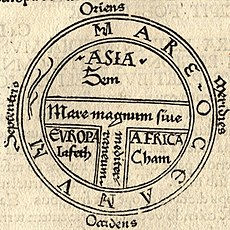
Islands are generally grouped with the nearest continental landmass, hence Iceland is considered to be part of Europe, while the nearby island of Greenland is usually assigned to North America, although politically belonging to Denmark. Nevertheless, there are some exceptions based on sociopolitical and cultural differences. Cyprus is closest to Anatolia (or Asia Minor), but is considered part of Europe politically and it is a member state of the EU. Malta was considered an island of Northwest Africa for centuries, but now it is considered to be part of Europe as well.[25] "Europe" as used specifically in British English may also refer to Continental Europe exclusively.[26]
The term "continent" usually implies the physical geography of a large land mass completely or almost completely surrounded by water at its borders. However the Europe-Asia part of the border is somewhat arbitrary and inconsistent with this definition because of its partial adherence to the Ural and Caucasus Mountains rather than a series of partly joined waterways suggested by cartographer Herman Moll in 1715. These water divides extend with a few relatively small interruptions (compared to the aforementioned mountain ranges) from the Turkish straits running into the Mediterranean Sea to the upper part of the Ob River that drains into the Arctic Ocean. Prior to the adoption of the current convention that includes mountain divides, the border between Europe and Asia had been redefined several times since its first conception in classical antiquity, but always as a series of rivers, seas, and straits that were believed to extend an unknown distance east and north from the Mediterranean Sea without the inclusion of any mountain ranges.
The current division of Eurasia into two continents now reflects East-West cultural, linguistic and ethnic differences which vary on a spectrum rather than with a sharp dividing line. The geographic border between Europe and Asia does not follow any state boundaries and now only follows a few bodies of water. Turkey is generally considered a transcontinental country divided entirely by water, while Russia and Kazakhstan are only partly divided by waterways. France, Portugal, the Netherlands, Spain and the United Kingdom are also transcontinental (or more properly, intercontinental, when oceans or large seas are involved) in that their main land areas are in Europe while pockets of their territories are located on other continents separated from Europe by large bodies of water. Spain, for example, has territories south of the Mediterranean Sea namely Ceuta and Melilla which are parts of Africa and share a border with Morocco. According to the current convention, Georgia and Azerbaijan are transcontinental countries where waterways have been completely replaced by mountains as the divide between continents.
History of the concept
Early history
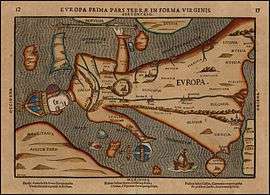
The first recorded usage of Eurṓpē as a geographic term is in the Homeric Hymn to Delian Apollo, in reference to the western shore of the Aegean Sea. As a name for a part of the known world, it is first used in the 6th century BC by Anaximander and Hecataeus. Anaximander placed the boundary between Asia and Europe along the Phasis River (the modern Rioni River on the territory of Georgia) in the Caucasus, a convention still followed by Herodotus in the 5th century BC.[27] Herodotus mentioned that the world had been divided by unknown persons into three parts, Europe, Asia, and Libya (Africa), with the Nile and the Phasis forming their boundaries—though he also states that some considered the River Don, rather than the Phasis, as the boundary between Europe and Asia.[28] Europe's eastern frontier was defined in the 1st century by geographer Strabo at the River Don.[29] The Book of Jubilees described the continents as the lands given by Noah to his three sons; Europe was defined as stretching from the Pillars of Hercules at the Strait of Gibraltar, separating it from Northwest Africa, to the Don, separating it from Asia.[30]
The convention received by the Middle Ages and surviving into modern usage is that of the Roman era used by Roman era authors such as Posidonius,[31] Strabo[32] and Ptolemy,[33] who took the Tanais (the modern Don River) as the boundary.
The term "Europe" is first used for a cultural sphere in the Carolingian Renaissance of the 9th century. From that time, the term designated the sphere of influence of the Western Church, as opposed to both the Eastern Orthodox churches and to the Islamic world.
A cultural definition of Europe as the lands of Latin Christendom coalesced in the 8th century, signifying the new cultural condominium created through the confluence of Germanic traditions and Christian-Latin culture, defined partly in contrast with Byzantium and Islam, and limited to northern Iberia, the British Isles, France, Christianised western Germany, the Alpine regions and northern and central Italy.[34] The concept is one of the lasting legacies of the Carolingian Renaissance: Europa often figures in the letters of Charlemagne's court scholar, Alcuin.[35]
Modern definitions
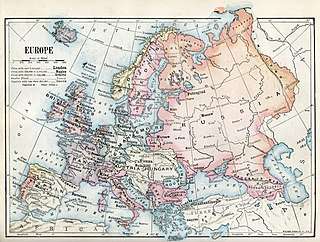
The question of defining a precise eastern boundary of Europe arises in the Early Modern period, as the eastern extension of Muscovy began to include North Asia. Throughout the Middle Ages and into the 18th century, the traditional division of the landmass of Eurasia into two continents, Europe and Asia, followed Ptolemy, with the boundary following the Turkish Straits, the Black Sea, the Kerch Strait, the Sea of Azov and the Don (ancient Tanais). But maps produced during the 16th to 18th centuries tended to differ in how to continue the boundary beyond the Don bend at Kalach-na-Donu (where it is closest to the Volga, now joined with it by the Volga–Don Canal), into territory not described in any detail by the ancient geographers. Around 1715, Herman Moll produced a map showing the northern part of the Ob River and the Irtysh River, a major tributary of the former, as components of a series of partly-joined waterways taking the boundary between Europe and Asia from the Turkish Straits and the Don River all the way to the Arctic Ocean. In 1721, he produced a more up to date map that was easier to read. However, his idea to use major rivers almost exclusively as the line of demarcation was never taken up by the Russian Empire.
Four years later, in 1725, Philip Johan von Strahlenberg was the first to depart from the classical Don boundary by proposing that mountain ranges could be included as boundaries between continents whenever there were deemed to be no suitable waterways, the Ob and Irtysh Rivers notwithstanding. He drew a new line along the Volga, following the Volga north until the Samara Bend, along Obshchy Syrt (the drainage divide between Volga and Ural) and then north along Ural Mountains.[36] This was adopted by the Russian Empire, and introduced the convention that would eventually become commonly accepted, but not without criticism by many modern analytical geographers like Halford Mackinder who saw little validity in the Ural Mountains as a boundary between continents.[37]
The mapmakers continued to differ on the boundary between the lower Don and Samara well into the 19th century. The 1745 atlas published by the Russian Academy of Sciences has the boundary follow the Don beyond Kalach as far as Serafimovich before cutting north towards Arkhangelsk, while other 18th- to 19th-century mapmakers such as John Cary followed Strahlenberg's prescription. To the south, the Kuma–Manych Depression was identified circa 1773 by a German naturalist, Peter Simon Pallas, as a valley that once connected the Black Sea and the Caspian Sea,[38][39] and subsequently was proposed as a natural boundary between continents.
By the mid-19th century, there were three main conventions, one following the Don, the Volga–Don Canal and the Volga, the other following the Kuma–Manych Depression to the Caspian and then the Ural River, and the third abandoning the Don altogether, following the Greater Caucasus watershed to the Caspian. The question was still treated as a "controversy" in geographical literature of the 1860s, with Douglas Freshfield advocating the Caucasus crest boundary as the "best possible", citing support from various "modern geographers".[40]
In Russia and the Soviet Union, the boundary along the Kuma–Manych Depression was the most commonly used as early as 1906.[41] In 1958, the Soviet Geographical Society formally recommended that the boundary between the Europe and Asia be drawn in textbooks from Baydaratskaya Bay, on the Kara Sea, along the eastern foot of Ural Mountains, then following the Ural River until the Mugodzhar Hills, and then the Emba River; and Kuma–Manych Depression,[42] thus placing the Caucasus entirely in Asia and the Urals entirely in Europe.[43] However, most geographers in the Soviet Union favoured the boundary along the Caucasus crest[44] and this became the common convention in the later 20th century, although the Kuma–Manych boundary remained in use in some 20th-century maps.
History
Prehistory
Homo erectus georgicus, which lived roughly 1.8 million years ago in Georgia, is the earliest hominid to have been discovered in Europe.[45] Other hominid remains, dating back roughly 1 million years, have been discovered in Atapuerca, Spain.[46] Neanderthal man (named after the Neandertal valley in Germany) appeared in Europe 150,000 years ago (115,000 years ago it is found already in Poland[47]) and disappeared from the fossil record about 28,000 years ago, with their final refuge being present-day Portugal. The Neanderthals were supplanted by modern humans (Cro-Magnons), who appeared in Europe around 43,000 to 40,000 years ago.[48] The earliest sites in Europe dated 48,000 years ago are Riparo Mochi (Italy), Geissenklösterle (Germany), and Isturitz (France)[49][50]
The European Neolithic period—marked by the cultivation of crops and the raising of livestock, increased numbers of settlements and the widespread use of pottery—began around 7000 BC in Greece and the Balkans, probably influenced by earlier farming practices in Anatolia and the Near East.[51] It spread from the Balkans along the valleys of the Danube and the Rhine (Linear Pottery culture) and along the Mediterranean coast (Cardial culture). Between 4500 and 3000 BC, these central European neolithic cultures developed further to the west and the north, transmitting newly acquired skills in producing copper artifacts. In Western Europe the Neolithic period was characterised not by large agricultural settlements but by field monuments, such as causewayed enclosures, burial mounds and megalithic tombs.[52] The Corded Ware cultural horizon flourished at the transition from the Neolithic to the Chalcolithic. During this period giant megalithic monuments, such as the Megalithic Temples of Malta and Stonehenge, were constructed throughout Western and Southern Europe.[53][54]
The European Bronze Age began c. 3200 BC in Greece with the Minoan civilisation on Crete, the first advanced civilisation in Europe.[55] The Minoans were followed by the Myceneans, who collapsed suddenly around 1200 BC, ushering the European Iron Age.[56] Iron Age colonisation by the Greeks and Phoenicians gave rise to early Mediterranean cities. Early Iron Age Italy and Greece from around the 8th century BC gradually gave rise to historical Classical antiquity, whose beginning is sometimes dated to 776 BC, the year the first Olympic Games.[57]
Classical antiquity
Ancient Greece was the founding culture of Western civilisation. Western democratic and rationalist culture are often attributed to Ancient Greece.[58] The Greek city-state, the polis, was the fundamental political unit of classical Greece.[58] In 508 BC, Cleisthenes instituted the world's first democratic system of government in Athens.[59] The Greek political ideals were rediscovered in the late 18th century by European philosophers and idealists. Greece also generated many cultural contributions: in philosophy, humanism and rationalism under Aristotle, Socrates and Plato; in history with Herodotus and Thucydides; in dramatic and narrative verse, starting with the epic poems of Homer;[60] in drama with Sophocles and Euripides, in medicine with Hippocrates and Galen; and in science with Pythagoras, Euclid and Archimedes.[61][62][63] In the course of the 5th century BC, several of the Greek city states would ultimately check the Achaemenid Persian advance in Europe through the Greco-Persian Wars, considered a pivotal moment in world history,[64] as the 50 years of peace that followed are known as Golden Age of Athens, the seminal period of ancient Greece that laid many of the foundations of Western civilisation. The conquests of Alexander the Great brought the Middle East into the Greek cultural sphere.
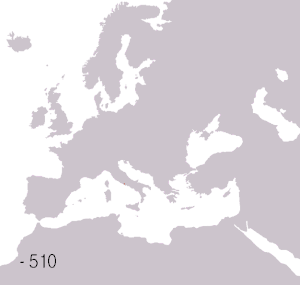
Greece was followed by Rome, which left its mark on law, politics, language, engineering, architecture, government and many more key aspects in western civilisation.[58] Rome began as a small city-state, founded, according to tradition, in 753 BC as an elective kingdom. Tradition has it that there were seven kings of Rome with Romulus, the founder, being the first and Lucius Tarquinius Superbus falling to a republican uprising led by Lucius Junius Brutus, but modern scholars doubt many of those stories and even the Romans themselves acknowledged that the sack of Rome by the Gauls in 387 BC destroyed many sources on their early history.
By 200 BC, Rome had conquered Italy, and over the following two centuries it conquered Greece and Hispania (Spain and Portugal), the North African coast, much of the Middle East, Gaul (France and Belgium), and Britannia (England and Wales). The forty-year conquest of Britannia left 250,000 Britons dead, and emperor Antoninus Pius built the Antonine Wall across Scotland's Central Belt to defend the province from the Caledonians; it marked the northernmost border of the Roman Empire.
The Roman Republic ended in 27 BC, when Augustus proclaimed the Roman Empire. The two centuries that followed are known as the pax romana, a period of unprecedented peace, prosperity, and political stability in most of Europe.[65] The empire continued to expand under emperors such as Antoninus Pius and Marcus Aurelius, who spent time on the Empire's northern border fighting Germanic, Pictish and Scottish tribes.[66][67] Christianity was legalised by Constantine I in 313 AD after three centuries of imperial persecution. Constantine also permanently moved the capital of the empire from Rome to the city of Byzantium, which was renamed Constantinople in his honour (modern-day Istanbul) in 330 AD. Christianity became the sole official religion of the empire in 380 AD, and in 391–392 AD, the emperor Theodosius outlawed pagan religions.[68] This is sometimes considered to mark the end of antiquity; alternatively antiquity is considered to end with the fall of the Western Roman Empire in 476 AD; the closure of the pagan Platonic Academy of Athens in 529 AD;[69] or the rise of Islam in the early 7th century AD.
Early Middle Ages
During the decline of the Roman Empire, Europe entered a long period of change arising from what historians call the "Age of Migrations". There were numerous invasions and migrations amongst the Goths, Vandals, Huns, Franks, Angles, Saxons, Slavs, Avars, Bulgars and, later on, the Vikings, Pechenegs, Cumans and Magyars.[65] Germanic tribes settled in the former Roman provinces of England and Spain, while other groups pressed into northern France and Italy.[70] Renaissance thinkers such as Petrarch would later refer to this as the "Dark Ages".[71] Isolated monastic communities were the only places to safeguard and compile written knowledge accumulated previously; apart from this very few written records survive and much literature, philosophy, mathematics, and other thinking from the classical period disappeared from Western Europe though they were preserved in the east, in the Byzantine Empire.[72] As the political boundaries of the Roman Empire collapsed in the west, Christianity spread beyond the old borders of the Empire and into lands that had never been under Rome.
While the Roman empire in the west continued to decline, Roman traditions and the Roman state remained strong in the predominantly Greek-speaking Eastern Roman Empire, also known as the Byzantine Empire. During most of its existence, the Byzantine Empire was the most powerful economic, cultural, and military force in Europe. Emperor Justinian I presided over Constantinople's first golden age: he established a legal code that forms the basis of many modern legal systems, funded the construction of the Hagia Sophia, and brought the Christian church under state control.[73] He reconquered North Africa, southern Spain, and Italy.[74] The Ostrogothic Kingdom, which sought to preserve Roman culture and adopt its values, later changed course and became anti-Constantinople, so Justinian waged war against the Ostrogoths for 30 years and destroyed much of urban life in Italy, and reduced agriculture to subsistence farming.[75]
During this period, the Roman Catholic Church expanded into northern Europe and spread Catholicism among the Germanic peoples.[76] Catholic Christianity reached the Vikings and other Scandinavians in later centuries.
From the 7th century onwards, as the Byzantines and neighbouring Sasanid Persians were severely weakened due the protracted, centuries-lasting and frequent Byzantine–Sasanian wars, the Muslim Arabs began to make inroads into historically Roman territory, taking the Levant and North Africa and making inroads into Asia Minor. In the mid 7th century AD, following the Muslim conquest of Persia, Islam penetrated into the Caucasus region.[77] Over the next centuries Muslim forces took Cyprus, Malta, Crete, Sicily and parts of southern Italy.[78] Between 711 and 726, the Umayyad Caliphate conquered the Visigothic Kingdom, which occupied the Iberian Peninsula and Septimania (southwestern France). The unsuccessful second siege of Constantinople (717) weakened the Umayyad dynasty and reduced their prestige. The Umayyads were then defeated by the Frankish leader Charles Martel at the Battle of Poitiers in 732, which ended their northward advance. In the remote regions of north-western Iberia and the middle Pyrenees the power of the Muslims in the south was scarcely felt. It was here that the foundations of the Christian kingdoms of Asturias, Leon and Galicia were laid and from where the reconquest of the Iberian Peninsula would start. However, no coordinated attempt would be made to drive the Moors out. The Christian kingdoms were mainly focussed on their own internal power struggles. As a result, the Reconquista took the greater part of eight hundred years, in which period a long list of Alfonsos, Sanchos, Ordoños, Ramiros, Fernandos and Bermudos would be fighting their Christian rivals as much as the Muslim invaders.
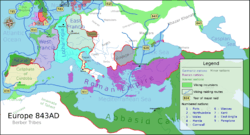
One of the biggest threats during the Dark Ages were the Vikings, Norse seafarers who raided, raped, and pillaged across the Western world. Many Vikings died in battles in continental Europe, and in 844 they lost many men and ships to King Ramiro in northern Spain.[79] A few months later, another fleet took Seville, only to be driven off with further heavy losses.[80] In 911, the Vikings attacked Paris, and the Franks decided to give the Viking king Rollo land along the English Channel coast in exchange for peace. This land was named "Normandy" for the Norse "Northmen", and the Norse settlers became known as "Normans", adopting the French culture and language and becoming French vassals. In 1066, the Normans went on to conquer England in the first successful cross-Channel invasion since Roman times.[81]
During the Dark Ages, the Western Roman Empire fell under the control of various tribes. The Germanic and Slav tribes established their domains over Western and Eastern Europe respectively.[82] Eventually the Frankish tribes were united under Clovis I.[83] His conquests laid the foundation for the Frankish kingdom. Charlemagne, a Frankish king of the Carolingian dynasty who had conquered most of Western Europe, was anointed "Holy Roman Emperor" by the Pope in 800. This led in 962 to the founding of the Holy Roman Empire, which eventually became centred in the German principalities of central Europe.[84]
East Central Europe saw the creation of the first Slavic states and the adoption of Christianity (circa 1000 AD). The powerful West Slavic state of Great Moravia spread its territory all the way south to the Balkans, reaching its largest territorial extent under Svatopluk I and causing a series of armed conflicts with East Francia. Further south, the first South Slavic states emerged in the late 7th and 8th century and adopted Christianity: the First Bulgarian Empire, the Serbian Principality (later Kingdom and Empire), and the Duchy of Croatia (later Kingdom of Croatia). To the East, the Kievan Rus expanded from its capital in Kiev to become the largest state in Europe by the 10th century. In 988, Vladimir the Great adopted Orthodox Christianity as the religion of state.[85][86] Further East, Volga Bulgaria became an Islamic state in the 10th century, but was eventually absorbed into Russia several centuries later.[87]
High and Late Middle Ages
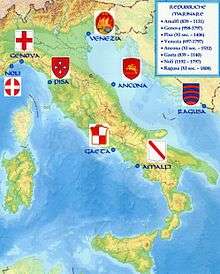
The period between the year 1000 and 1300 is known as the High Middle Ages, during which the population of Europe experienced significant growth, culminating in the Renaissance of the 12th century. Economic growth, together with the lack of safety on the mainland trading routes, made possible the development of major commercial routes along the coast of the Mediterranean and Baltic Seas. The growing wealth and independence acquired by some coastal cities gave the Maritime Republics a leading role in the European scene. Constantinople was the largest and wealthiest city in Europe from the 9th to the 12th centuries, with a population of approximately 400,000.[90]
The Middle Ages on the mainland were dominated by the two upper echelons of the social structure: the nobility and the clergy. Feudalism developed in France in the Early Middle Ages and soon spread throughout Europe.[91] A struggle for influence between the nobility and the monarchy in England led to the writing of the Magna Carta and the establishment of a parliament.[92] The primary source of culture in this period came from the Roman Catholic Church. Through monasteries and cathedral schools, the Church was responsible for education in much of Europe.[91]
.jpg)
The Papacy reached the height of its power during the High Middle Ages. An East-West Schism in 1054 split the former Roman Empire religiously, with the Eastern Orthodox Church in the Byzantine Empire and the Roman Catholic Church in the former Western Roman Empire. In 1095, Pope Urban II called for a crusade against Muslims occupying Jerusalem and the Holy Land.[93] In Europe itself, the Church organised the Inquisition against heretics. Popes also encouraged crusading in the Iberian Peninsula.[94] In the east, a resurgent Byzantine Empire recaptured Crete and Cyprus from the Muslims and reconquered the Balkans. However, it faced a new enemy in the form of seaborne attacks by the Normans, who conquered Southern Italy and Sicily. Even more dangerous than the Franco-Norsemen was a new enemy from the steppe: the Seljuk Turks. The Empire was weakened following the defeat at the Battle of Manzikert and was weakened considerably by the Frankish-Venetian sack of Constantinople in 1204, during the Fourth Crusade.[95][96][97][98][99][100][101][102][103] Although it would recover Constantinople in 1261, Byzantium fell in 1453 when Constantinople was taken by the Ottoman Empire.[104][105][106]
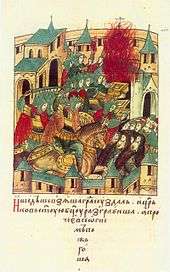
In the 11th and 12th centuries, constant incursions by nomadic Turkic tribes, such as the Pechenegs and the Cuman-Kipchaks, caused a massive migration of Slavic populations to the safer, heavily forested regions of the north and temporarily halted the expansion of the Rus' state to the south and east.[107] Like many other parts of Eurasia, these territories were overrun by the Mongols.[108] The invaders, who became known as Tatars, were mostly Turkic-speaking peoples under Mongol suzerainty. They established the state of the Golden Horde with headquarters in Crimea, which later adopted Islam as a religion and ruled over modern-day southern and central Russia for more than three centuries.[109][110] After the collapse of Mongol dominions, the first Romanian states (principalities) emerged in the 14th century: Moldova and Walachia. Previously, these territories were under the successive control of Pechenegs and Cumans.[111] From the 12th to the 15th centuries, the Grand Duchy of Moscow grew from a small principality under Mongol rule to the largest state in Europe, overthrowing the Mongols in 1480 and eventually becoming the Tsardom of Russia. The state was consolidated under Ivan III the Great and Ivan the Terrible, steadily expanding to the east and south over the next centuries.
The Great Famine of 1315–1317 was the first crisis that would strike Europe in the late Middle Ages.[112] The period between 1348 and 1420 witnessed the heaviest loss. The population of France was reduced by half.[113][114] Medieval Britain was afflicted by 95 famines,[115] and France suffered the effects of 75 or more in the same period.[116] Europe was devastated in the mid-14th century by the Black Death, one of the most deadly pandemics in human history which killed an estimated 25 million people in Europe alone—a third of the European population at the time.[117]
The plague had a devastating effect on Europe's social structure; it induced people to live for the moment as illustrated by Giovanni Boccaccio in The Decameron (1353). It was a serious blow to the Roman Catholic Church and led to increased persecution of Jews, beggars, and lepers.[118] The plague is thought to have returned every generation with varying virulence and mortalities until the 18th century.[119] During this period, more than 100 plague epidemics swept across Europe.[120]
Early modern period
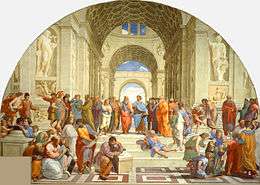
The Renaissance was a period of cultural change originating in Florence and later spreading to the rest of Europe. The rise of a new humanism was accompanied by the recovery of forgotten classical Greek and Arabic knowledge from monastic libraries, often translated from Arabic into Latin.[121][122][123] The Renaissance spread across Europe between the 14th and 16th centuries: it saw the flowering of art, philosophy, music, and the sciences, under the joint patronage of royalty, the nobility, the Roman Catholic Church, and an emerging merchant class.[124][125][126] Patrons in Italy, including the Medici family of Florentine bankers and the Popes in Rome, funded prolific quattrocento and cinquecento artists such as Raphael, Michelangelo, and Leonardo da Vinci.[127][128]
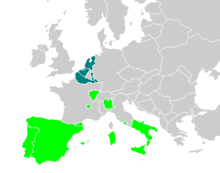
Political intrigue within the Church in the mid-14th century caused the Western Schism. During this forty-year period, two popes—one in Avignon and one in Rome—claimed rulership over the Church. Although the schism was eventually healed in 1417, the papacy's spiritual authority had suffered greatly.[131] In the 15th century, Europe started to extend itself beyond its geographic frontiers. Spain and Portugal, the greatest naval powers of the time, took the lead in exploring the world.[132][133] Exploration reached the Southern Hemisphere in the Atlantic and the Southern tip of Africa. Christopher Columbus reached the New World in 1492, and Vasco da Gama opened the ocean route to the East linking the Atlantic and Indian Oceans in 1498. Ferdinand Magellan reached Asia westward across the Atlantic and the Pacific Oceans in the Spanish expedition of Magellan-Elcano, resulting in the first circumnavigation of the globe, completed by Juan Sebastián Elcano (1519–22). Soon after, the Spanish and Portuguese began establishing large global empires in the Americas, Asia, Africa and Oceania.[134] France, the Dutch Republic and England soon followed in building large colonial empires with vast holdings in Africa, the Americas, and Asia. The Italian Wars (1494–1559) led to the development of the first modern professional army in Europe, the Tercios. Their superiority became evident at the Battle of Bicocca (1522) against French-Swiss-Italian forces, which marked the end of massive pike assaults after thousands of Swiss pikemen fell to the Spanish arquebusiers without the latter suffering a single casualty.[135] Over the course of the 16th century, Spanish and Italian troops marched north to fight on Dutch and German battlefields, dying there in large numbers.[136][137]
The Church's power was further weakened by the Protestant Reformation in 1517 when German theologian Martin Luther nailed his Ninety-five Theses criticising the selling of indulgences to the church door. He was subsequently excommunicated in the papal bull Exsurge Domine in 1520, and his followers were condemned in the 1521 Diet of Worms, which divided German princes between Protestant and Roman Catholic faiths.[138] By the mid-1560s, two discernible opposing blocs had taken shape: a southern European Catholic bloc led by Spain and a northern European bloc led by England. English Protestants viewed Spain and the Society of Jesus together as a growing force attempting to conquer England for Rome.[139]
Religious fighting and warfare spread with Protestantism. War broke out first in Germany, where Imperial troops defeated the Protestant army of the Schmalkaldic League at the Battle of Mühlberg, putting an end to the Schmalkaldic War (1546–47).[140] Between 2 and 3 million people were killed in the French Wars of Religion (1562–98).[141] The Eighty Years' War (1568–1648) between Catholic Habsburgs and Dutch Calvinists resulted in the death of hundreds of thousands of people.[141] In the Cologne War (1583–88), Catholic forces faced off against German Calvinist and Dutch troops. The Thirty Years War (1618–48) crippled the Holy Roman Empire and devastated much of Germany, killing between 25 and 40 percent of its population.[142] During the Thirty Years' War, in which various Protestant forces battled Imperial armies, France provided subsidies to Habsburg enemies, especially Sweden. The destruction of the Swedish army by an Austro-Spanish force at the Battle of Nördlingen (1634) forced France to intervene militarily in the Thirty Years' War. In 1643, the French defeated one of Spain's best armies at the Battle of Rocroi. Spain was no longer able to launch major offensive operations in central Europe.[143] In the aftermath of the Peace of Westphalia (1648), France rose to predominance within Western Europe.[144] France fought a series of wars over domination of Western Europe, including the Franco-Spanish War, the Franco-Dutch War, the Nine Years' War, and the War of the Spanish Succession; these wars cost France over 1,000,000 battle casualties.[145][146]
The 17th century in central and eastern Europe was a period of general decline.[147] Central and Eastern Europe experienced more than 150 famines in a 200-year period between 1501 and 1700.[148] From the Union of Krewo (1385) central and eastern Europe was dominated by Kingdom of Poland and Grand Duchy of Lithuania. Between 1648 and 1655 in the central and eastern Europe ended hegemony of the Polish–Lithuanian Commonwealth. From the 15th to 18th centuries, when the disintegrating khanates of the Golden Horde were conquered by Russia, Tatars from the Crimean Khanate frequently raided Eastern Slavic lands to capture slaves.[149] Further east, the Nogai Horde and Kazakh Khanate frequently raided the Slavic-speaking areas of Russia, Ukraine and Poland for hundreds of years, until the Russian expansion and conquest of most of northern Eurasia (i.e. Eastern Europe, Central Asia and Siberia).
The Renaissance and the New Monarchs marked the start of an Age of Discovery, a period of exploration, invention, and scientific development.[150] Among the great figures of the Western scientific revolution of the 16th and 17th centuries were Copernicus, Kepler, Galileo, and Isaac Newton.[151] According to Peter Barrett, "It is widely accepted that 'modern science' arose in the Europe of the 17th century (towards the end of the Renaissance), introducing a new understanding of the natural world."[121]
18th and 19th centuries
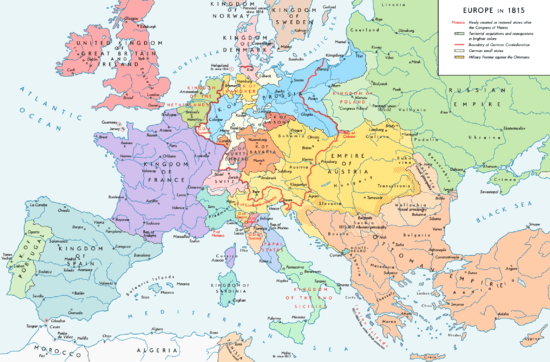
The Age of Enlightenment was a powerful intellectual movement during the 18th century promoting scientific and reason-based thoughts.[152][153][154] Discontent with the aristocracy and clergy's monopoly on political power in France resulted in the French Revolution and the establishment of the First Republic as a result of which the monarchy and many of the nobility perished during the initial reign of terror.[155] Napoleon Bonaparte rose to power in the aftermath of the French Revolution and established the First French Empire that, during the Napoleonic Wars, grew to encompass large parts of western and central Europe before collapsing in 1814 with the Battle of Paris between the Sixth Coalition—consisting of Russia, Austria, and Prussia—and the French Empire.[156][157] Napoleonic rule resulted in the further dissemination of the ideals of the French Revolution, including that of the nation-state, as well as the widespread adoption of the French models of administration, law, and education.[158][159][160] The Congress of Vienna, convened after Napoleon's downfall, established a new balance of power in Europe centred on the five "Great Powers": the UK, France, Prussia, Austria, and Russia.[161] This balance would remain in place until the Revolutions of 1848, during which liberal uprisings affected all of Europe except for Russia and the UK. These revolutions were eventually put down by conservative elements and few reforms resulted.[162] The year 1859 saw the unification of Romania, as a nation-state, from smaller principalities. In 1867, the Austro-Hungarian empire was formed; and 1871 saw the unifications of both Italy and Germany as nation-states from smaller principalities.[163]
In parallel, the Eastern Question grew more complex ever since the Ottoman defeat in the Russo-Turkish War (1768–1774). As the dissolution of the Ottoman Empire seemed imminent, the Great Powers struggled to safeguard their strategic and commercial interests in the Ottoman domains. The Russian Empire stood to benefit from the decline, whereas the Habsburg Empire and Britain perceived the preservation of the Ottoman Empire to be in their best interests. Meanwhile, the Serbian revolution (1804) and Greek War of Independence (1821) marked the beginning of the end of Ottoman rule in the Balkans, which ended with the Balkan Wars in 1912–1913.[164] Formal recognition of the de facto independent principalities of Montenegro, Serbia and Romania ensued at the Congress of Berlin in 1878. Many Ottoman Muslims faced either extermination at the hands of the newly independent states, or were expelled to the shrinking Ottoman possessions in Europe or to Anatolia; between 1821 and 1922 alone, more than 5 million Ottoman Muslims were driven away from their homes, while another 5.5 million died in wars or due to starvation and disease.[165]
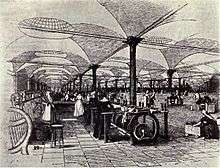
The Industrial Revolution started in Great Britain in the last part of the 18th century and spread throughout Europe. The invention and implementation of new technologies resulted in rapid urban growth, mass employment, and the rise of a new working class.[166] Reforms in social and economic spheres followed, including the first laws on child labour, the legalisation of trade unions,[167] and the abolition of slavery.[168] In Britain, the Public Health Act of 1875 was passed, which significantly improved living conditions in many British cities.[169] Europe's population increased from about 100 million in 1700 to 400 million by 1900.[170] The last major famine recorded in Western Europe, the Irish Potato Famine, caused death and mass emigration of millions of Irish people.[171] In the 19th century, 70 million people left Europe in migrations to various European colonies abroad and to the United States.[172] Demographic growth meant that, by 1900, Europe's share of the world's population was 25%.[173]
20th century to the present
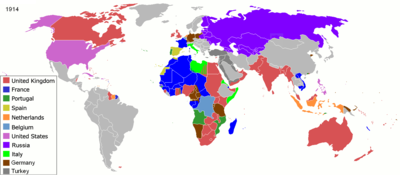
Two world wars and an economic depression dominated the first half of the 20th century. World War I was fought between 1914 and 1918. It started when Archduke Franz Ferdinand of Austria was assassinated by the Yugoslav nationalist[179] Gavrilo Princip.[180] Most European nations were drawn into the war, which was fought between the Entente Powers (France, Belgium, Serbia, Portugal, Russia, the United Kingdom, and later Italy, Greece, Romania, and the United States) and the Central Powers (Austria-Hungary, Germany, Bulgaria, and the Ottoman Empire).
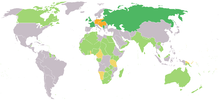
On 4 August 1914, Germany invaded and occupied Belgium. On 17 August 1914, the Russian army launched an assault on the eastern German province of East Prussia, but they would be dealt a fatal blow at the Battle of Tannenberg on 26-30 August 1914. As 1914 came to a close, the Germans were facing off against the French and British in northern France and in the Alsace and Lorraine regions of eastern France, and the opposing armies dug trenches and set up defensive positions. From 1915 to 1917, the two armies often engaged in trench warfare and massive offensives. The Battle of the Somme was the largest battle on the Western Front; the British suffered 420,000 casualties, the French 200,000 and the Germans 500,000. The Battle of Verdun saw around 377,231 French and 337,000 Germans become casualties. At the Battle of Passchendaele, mustard gas was used by both sides as chemical weapons, and several troops on both sides died in battle. In 1915, the tide of the war was changed when the Kingdom of Italy decided to enter the war on the side of the Triple Entente, seeking to acquire Austrian Tyrol and some possessions along the Adriatic Sea. This violated the "Triple Alliance" proposed in the 19th century, and Austria-Hungary was ill-prepared for yet another front to fight on. The Royal Italian Army launched several offensives along the Isonzo River, with eleven battles of the Isonzo being fought during the war. Over the course of the war, 462,391 Italian soldiers died; 420,000 of the dead were lost on the Alpine front with Austria-Hungary, the rest fell in France, Albania, or Macedonia.[181]
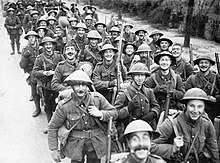
In 1917, German troops began to arrive in Italy to assist the crumbling Austro-Hungarian forces, and the Germans destroyed an Italian army at the Battle of Caporetto. This led to British and French (and later American) troops arriving in Italy to assist the Italian military against the Central forces, and the Allied troops succeeded in taking parts of northern Italy and on the Adriatic sea. In the Balkans, the Serbians resisted the Austrians until Bulgaria and the German Empire sent troops to assist in the conquest of Serbia in December 1915. The Austro-Hungarian Army on the Eastern Front, which had performed poorly, was soon subordinated to the Imperial German Army's high command, and the Germans destroyed a Russian army at the Gorlice-Tarnow Offensive in 1916. The Russians launched a massive counterattack against the Central Powers in Poland, and this "Brusilov Offensive" inflicted very high losses on the Austro-Hungarians; 1,325,000 Central Powers troops and 500,000 Russian troops were lost. However, the political situation in Russia deteriorated as people became more aware of the corruption in Czar Nicholas II of Russia's government, and the Germans made rapid progress in 1917 after the Russian Revolution toppled the czar. The Germans secured Riga in Latvia in September 1917, and they benefited from the fall of Aleksandr Kerensky's provisional government to the Bolsheviks in October 1917. In February-March 1918, the Germans launched a massive offensive after the Russian SFSR came to power, taking advantage of the Russian Civil War to seize large amounts of territory. In March 1918, the Soviets signed the Treaty of Brest-Litovsk, ending the war on the Eastern Front, and Germany set up various puppet nations in Eastern Europe.
Germany's huge successes during the war with the Russians were morale boosts for the Central Powers, but the Germans faced a new problem when they began to use "unrestricted submarine warfare" to attack enemy ships at sea. These tactics led to the sinking of several civilian ships, angering the United States, which lost several civilians aboard these ships. Germany agreed to the "Sussex Pledge", stating that it would halt this strategy. However, the Germans sunk RMS Lusitania on 7 May 1915, and the British intercepted an offer from the German government made to Mexico that proposed an anti-American alliance. In 1916, President Woodrow Wilson declared war on Germany, and the USA joined the Allies. In 1918, the American troops took part in the Battle of Belleau Wood and in the Meuse-Argonne Offensive, major offensives that saw several American troops die on European soil for the first time. The Germans began to suffer as more and more Allied troops arrived, and they launched the desperate "Spring Offensive" of 1918. This offensive was repelled, and the Allies barreled towards Belgium in the Hundred Days Offensive during the autumn of 1918. On 11 November 1918, the Germans agreed to an armistice with the Allies, ending the war. The war left more than 16 million civilians and military dead.[182] Over 60 million European soldiers were mobilised from 1914 to 1918.[183]
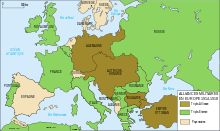
Russia was plunged into the Russian Revolution, which threw down the Tsarist monarchy and replaced it with the communist Soviet Union.[184] Austria-Hungary and the Ottoman Empire collapsed and broke up into separate nations, and many other nations had their borders redrawn. The Treaty of Versailles, which officially ended World War I in 1919, was harsh towards Germany, upon whom it placed full responsibility for the war and imposed heavy sanctions.[185] Excess deaths in Russia over the course of World War I and the Russian Civil War (including the postwar famine) amounted to a combined total of 18 million.[186] In 1932–1933, under Stalin's leadership, confiscations of grain by the Soviet authorities contributed to the second Soviet famine which caused millions of deaths;[187] surviving kulaks were persecuted and many sent to Gulags to do forced labour. Stalin was also responsible for the Great Purge of 1937–38 in which the NKVD executed 681,692 people;[188] millions of people were deported and exiled to remote areas of the Soviet Union.[189]
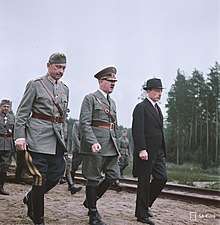
The social revolutions sweeping through Russia also affected other European nations following The Great War: in 1919, with the Weimar Republic in Germany, and the First Austrian Republic; in 1922, with Mussolini's one party fascist government in the Kingdom of Italy, and in Atatürk's Turkish Republic, adopting the Western alphabet, and state secularism. Economic instability, caused in part by debts incurred in the First World War and 'loans' to Germany played havoc in Europe in the late 1920s and 1930s. This and the Wall Street Crash of 1929 brought about the worldwide Great Depression. Helped by the economic crisis, social instability and the threat of communism, fascist movements developed throughout Europe placing Adolf Hitler in power of what became Nazi Germany.[199][200] In 1933, Hitler became the leader of Germany and began to work towards his goal of building Greater Germany. Germany re-expanded and took back the Saarland and Rhineland in 1935 and 1936. In 1938, Austria became a part of Germany following the Anschluss. Later that year, following the Munich Agreement signed by Germany, France, the United Kingdom and Italy, Germany annexed the Sudetenland, which was a part of Czechoslovakia inhabited by ethnic Germans, and in early 1939, the remainder of Czechoslovakia was split into the Protectorate of Bohemia and Moravia, controlled by Germany, and the Slovak Republic. At the time, Britain and France preferred a policy of appeasement.
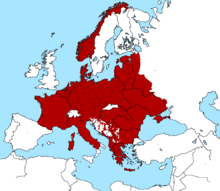
With tensions mounting between Germany and Poland over the future of Danzig, the Germans turned to the Soviets, and signed the Molotov–Ribbentrop Pact, which allowed the Soviets to invade the Baltic states and parts of Poland and Romania. Germany invaded Poland on 1 September 1939, prompting France and the United Kingdom to declare war on Germany on 3 September, opening the European Theatre of World War II.[195][201][202] The Soviet invasion of Poland started on 17 September and Poland fell soon thereafter. On 24 September, the Soviet Union attacked the Baltic countries and later, Finland. The British hoped to land at Narvik and send troops to aid Finland, but their primary objective in the landing was to encircle Germany and cut the Germans off from Scandinavian resources. Around the same time, Germany moved troops into Denmark; 1,400 Nazi soldiers conquered Denmark in one day.[203] The Phoney War continued. In May 1940, Germany conquered the Netherlands and Belgium. That same month, Italy allied with Germany and the two countries conquered France. By August, Germany began a bombing offensive on Britain, but failed to convince the Britons to give up.[204] Some 43,000 British civilians were killed and 139,000 wounded in the Blitz; much of London was destroyed, with 1,400,245 buildings destroyed or damaged.[205] In April 1941, Germany invaded Yugoslavia. In June 1941, Germany invaded the Soviet Union in Operation Barbarossa.[206] The Soviets and Germans fought an extremely brutal war in the east that cost millions of civilian and soldier lives. The Jews of Russia were wiped out by the German Nazis, who wanted to purge the world of Jews and other "subhumans". On 7 December 1941 Japan's attack on Pearl Harbor drew the United States into the conflict as allies of the British Empire and other allied forces.[207][208] In 1943, the Allies knocked Italy out of the war. The Italian campaign had the highest casualty rates of the whole war for the western allies.[209]
_(B%26W).jpg)
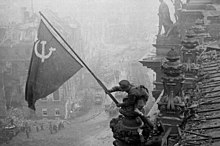
After the staggering Battle of Stalingrad in 1943, the German offensive in the Soviet Union turned into a continual fallback. The Battle of Kursk, which involved the largest tank battle in history, was the last major German offensive on the Eastern Front. In 1944, the Soviets and Allies both launched offensives against the Axis in Europe, with the Western Allies liberating France and much of Western Europe as the Soviets liberated much of Eastern Europe before halting in central Poland. The final year of the war saw the Soviets and Western Allies divide Germany in two after meeting along the Elbe River, while the Soviets and allied partisans liberated the Balkans. The Soviets conquered the German capital of Berlin on 2 May 1945, ending World War II in Europe. Hitler killed himself; Mussolini was killed by partisans in Italy. The Soviet-German struggle made World War II the bloodiest and costliest conflict in history.[210][211] More than 40 million people in Europe had died as a result of World War II (70 percent on the eastern front),[212][213] including between 11 and 17 million people who perished during the Holocaust (the genocide against Jews and the massacre of intellectuals, gypsies, homosexuals, handicapped people, Slavs, and Red Army prisoners-of-war).[214] The Soviet Union lost around 27 million people during the war, about half of all World War II casualties.[215] By the end of World War II, Europe had more than 40 million refugees.[216] Several post-war expulsions in Central and Eastern Europe displaced a total of about 20 million people,[217] in particular, German-speakers from all over Eastern Europe. In the aftermath of World War II, American troops were stationed in Western Europe, while Soviet troops occupied several Central and Eastern European states.
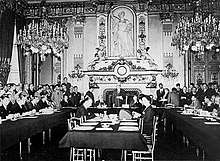
World War I and especially World War II diminished the eminence of Western Europe in world affairs. After World War II the map of Europe was redrawn at the Yalta Conference and divided into two blocs, the Western countries and the communist Eastern bloc, separated by what was later called by Winston Churchill an "Iron Curtain". Germany was divided between the capitalist West Germany and the communist East Germany. The United States and Western Europe established the NATO alliance and later the Soviet Union and Central Europe established the Warsaw Pact.[218]
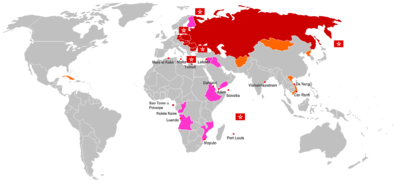
The two new superpowers, the United States and the Soviet Union, became locked in a fifty-year-long Cold War, centred on nuclear proliferation. At the same time decolonisation, which had already started after World War I, gradually resulted in the independence of most of the European colonies in Asia and Africa.[13] During the Cold War, extra-continental military interventions were the preserve of the two superpowers, a few West European countries, and Cuba.[219] Using the small Caribbean nation of Cuba as a surrogate, the Soviets projected power to distant points of the globe, exploiting world trouble spots without directly involving their own troops.[220]

In the 1980s the reforms of Mikhail Gorbachev and the Solidarity movement in Poland accelerated the collapse of the Eastern bloc and the end of the Cold War. Germany was reunited, after the symbolic fall of the Berlin Wall in 1989, and the maps of Central and Eastern Europe were redrawn once more.[199] European integration also grew after World War II. In 1949 the Council of Europe was founded, following a speech by Sir Winston Churchill, with the idea of unifying Europe to achieve common goals. It includes all European states except for Belarus and Vatican City. The Treaty of Rome in 1957 established the European Economic Community between six Western European states with the goal of a unified economic policy and common market.[222] In 1967 the EEC, European Coal and Steel Community and Euratom formed the European Community, which in 1993 became the European Union. The EU established a parliament, court and central bank and introduced the euro as a unified currency.[223] Between 2004 and 2013, more Central and Eastern European countries began joining, expanding the EU to 28 European countries, and once more making Europe a major economical and political centre of power.[224] However, the United Kingdom withdrew from the EU on 31 January 2020, as a result of a June 2016 referendum on EU membership.[225]
Geography
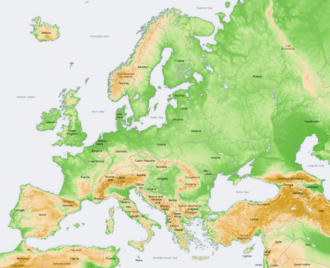
Europe makes up the western fifth of the Eurasian landmass.[24] It has a higher ratio of coast to landmass than any other continent or subcontinent.[226] Its maritime borders consist of the Arctic Ocean to the north, the Atlantic Ocean to the west, and the Mediterranean, Black, and Caspian Seas to the south.[227] Land relief in Europe shows great variation within relatively small areas. The southern regions are more mountainous, while moving north the terrain descends from the high Alps, Pyrenees, and Carpathians, through hilly uplands, into broad, low northern plains, which are vast in the east. This extended lowland is known as the Great European Plain, and at its heart lies the North German Plain. An arc of uplands also exists along the north-western seaboard, which begins in the western parts of the islands of Britain and Ireland, and then continues along the mountainous, fjord-cut spine of Norway.
This description is simplified. Sub-regions such as the Iberian Peninsula and the Italian Peninsula contain their own complex features, as does mainland Central Europe itself, where the relief contains many plateaus, river valleys and basins that complicate the general trend. Sub-regions like Iceland, Britain, and Ireland are special cases. The former is a land unto itself in the northern ocean which is counted as part of Europe, while the latter are upland areas that were once joined to the mainland until rising sea levels cut them off.
Climate
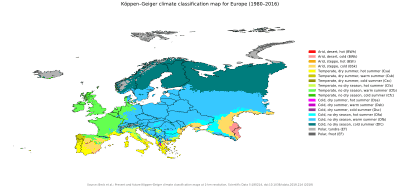
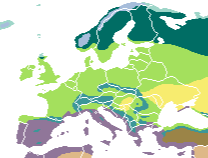
tundra alpine tundra taiga montane forest
temperate broadleaf forest mediterranean forest temperate steppe dry steppe
Europe lies mainly in the temperate climate zones, being subjected to prevailing westerlies. The climate is milder in comparison to other areas of the same latitude around the globe due to the influence of the Gulf Stream.[229] The Gulf Stream is nicknamed "Europe's central heating", because it makes Europe's climate warmer and wetter than it would otherwise be. The Gulf Stream not only carries warm water to Europe's coast but also warms up the prevailing westerly winds that blow across the continent from the Atlantic Ocean.
Therefore, the average temperature throughout the year of Naples is 16 °C (61 °F), while it is only 12 °C (54 °F) in New York City which is almost on the same latitude. Berlin, Germany; Calgary, Canada; and Irkutsk, in the Asian part of Russia, lie on around the same latitude; January temperatures in Berlin average around 8 °C (14 °F) higher than those in Calgary, and they are almost 22 °C (40 °F) higher than average temperatures in Irkutsk.[229] Similarly, northern parts of Scotland have a temperate marine climate. The yearly average temperature in city of Inverness is 9.05 °C (48.29 °F). However, Churchill, Manitoba, Canada, is on roughly the same latitude and has an average temperature of −6.5 °C (20.3 °F), giving it a nearly subarctic climate.
In general, Europe is not just colder towards the north compared to the south, but it also gets colder from the west towards the east. The climate is more oceanic in the west, and less so in the east. This can be illustrated by the following table of average temperatures at locations roughly following the 60th, 55th, 50th, 45th and 40th latitudes. None of them is located at high altitude; most of them are close to the sea. (location, approximate latitude and longitude, coldest month average, hottest month average and annual average temperatures in degrees C)
| Location | Latitude | Longitude | Coldest month | Hottest month | Annual average |
|---|---|---|---|---|---|
| Lerwick | 60 N | 1 W | 3.5 | 12.4 | 7.4 |
| Stockholm | 59.5 N | 19 E | −1.7 | 18.4 | 7.4 |
| Helsinki | 60 N | 25 E | −4.7 | 17.8 | 5.9 |
| Saint Petersburg | 60 N | 30 E | −5.8 | 18.8 | 5.8 |
| Edinburgh | 55.5 N | 3 W | 4.2 | 15.3 | 9.3 |
| Copenhagen | 55.5 N | 12 E | 1.4 | 18.1 | 9.1 |
| Klaipeda | 55.5 N | 21 E | −1.3 | 17.9 | 8.0 |
| Moscow | 55.5 N | 30 E | −6.5 | 19.2 | 5.8 |
| Isles of Scilly | 50 N | 6 W | 7.9 | 16.9 | 11.8 |
| Brussels | 50.5 N | 4 E | 3.3 | 18.4 | 10.5 |
| Krakow | 50 N | 20 E | −2.0 | 19.2 | 8.7 |
| Kiev | 50.5 N | 30 E | −3.5 | 20.5 | 8.4 |
| Bordeaux | 45 N | 0 | 6.6 | 21.4 | 13.8 |
| Venice | 45.5 N | 12 E | 3.3 | 23.0 | 13.0 |
| Belgrade | 45 N | 20 E | 1.4 | 23.0 | 12.5 |
| Astrakhan | 46 N | 48 E | −3.7 | 25.6 | 10.5 |
| Coimbra | 40 N | 8 W | 9.9 | 21.9 | 16.0 |
| Valencia | 39.5 N | 0 | 11.9 | 26.1 | 18.4 |
| Naples | 40.5 N | 14 E | 8.7 | 24.7 | 15.6 |
| Istanbul | 41 N | 29 E | 6.0 | 23.8 | 11.4 |
[230] It is notable how the average temperatures for the coldest month, as well as the annual average temperatures, drop from the west to the east. For instance, Edinburgh is warmer than Belgrade during the coldest month of the year, although Belgrade is around 10° of latitude farther south.
Geology
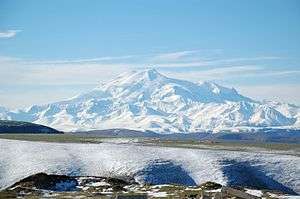
The geological history of Europe traces back to the formation of the Baltic Shield (Fennoscandia) and the Sarmatian craton, both around 2.25 billion years ago, followed by the Volgo–Uralia shield, the three together leading to the East European craton (≈ Baltica) which became a part of the supercontinent Columbia. Around 1.1 billion years ago, Baltica and Arctica (as part of the Laurentia block) became joined to Rodinia, later resplitting around 550 million years ago to reform as Baltica. Around 440 million years ago Euramerica was formed from Baltica and Laurentia; a further joining with Gondwana then leading to the formation of Pangea. Around 190 million years ago, Gondwana and Laurasia split apart due to the widening of the Atlantic Ocean. Finally, and very soon afterwards, Laurasia itself split up again, into Laurentia (North America) and the Eurasian continent. The land connection between the two persisted for a considerable time, via Greenland, leading to interchange of animal species. From around 50 million years ago, rising and falling sea levels have determined the actual shape of Europe, and its connections with continents such as Asia. Europe's present shape dates to the late Tertiary period about five million years ago.[233]
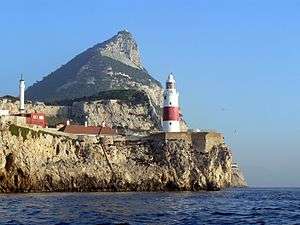
The geology of Europe is hugely varied and complex, and gives rise to the wide variety of landscapes found across the continent, from the Scottish Highlands to the rolling plains of Hungary.[234] Europe's most significant feature is the dichotomy between highland and mountainous Southern Europe and a vast, partially underwater, northern plain ranging from Ireland in the west to the Ural Mountains in the east. These two halves are separated by the mountain chains of the Pyrenees and Alps/Carpathians. The northern plains are delimited in the west by the Scandinavian Mountains and the mountainous parts of the British Isles. Major shallow water bodies submerging parts of the northern plains are the Celtic Sea, the North Sea, the Baltic Sea complex and Barents Sea.
The northern plain contains the old geological continent of Baltica, and so may be regarded geologically as the "main continent", while peripheral highlands and mountainous regions in the south and west constitute fragments from various other geological continents. Most of the older geology of western Europe existed as part of the ancient microcontinent Avalonia.
Flora
Having lived side by side with agricultural peoples for millennia, Europe's animals and plants have been profoundly affected by the presence and activities of man. With the exception of Fennoscandia and northern Russia, few areas of untouched wilderness are currently found in Europe, except for various national parks.
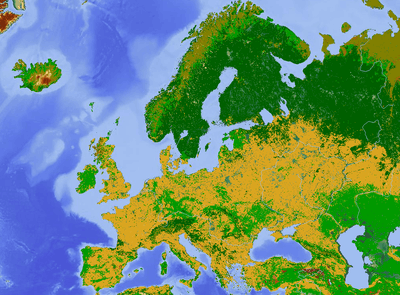
The main natural vegetation cover in Europe is mixed forest. The conditions for growth are very favourable. In the north, the Gulf Stream and North Atlantic Drift warm the continent. Southern Europe could be described as having a warm, but mild climate. There are frequent summer droughts in this region. Mountain ridges also affect the conditions. Some of these (Alps, Pyrenees) are oriented east–west and allow the wind to carry large masses of water from the ocean in the interior. Others are oriented south–north (Scandinavian Mountains, Dinarides, Carpathians, Apennines) and because the rain falls primarily on the side of mountains that is oriented towards the sea, forests grow well on this side, while on the other side, the conditions are much less favourable. Few corners of mainland Europe have not been grazed by livestock at some point in time, and the cutting down of the pre-agricultural forest habitat caused disruption to the original plant and animal ecosystems.
.png)
Probably 80 to 90 percent of Europe was once covered by forest.[235] It stretched from the Mediterranean Sea to the Arctic Ocean. Although over half of Europe's original forests disappeared through the centuries of deforestation, Europe still has over one quarter of its land area as forest, such as the broadleaf and mixed forests, taiga of Scandinavia and Russia, mixed rainforests of the Caucasus and the Cork oak forests in the western Mediterranean. During recent times, deforestation has been slowed and many trees have been planted. However, in many cases monoculture plantations of conifers have replaced the original mixed natural forest, because these grow quicker. The plantations now cover vast areas of land, but offer poorer habitats for many European forest dwelling species which require a mixture of tree species and diverse forest structure. The amount of natural forest in Western Europe is just 2–3% or less, in European Russia 5–10%. The country with the smallest percentage of forested area is Iceland (1%), while the most forested country is Finland (77%).[236]
In temperate Europe, mixed forest with both broadleaf and coniferous trees dominate. The most important species in central and western Europe are beech and oak. In the north, the taiga is a mixed spruce–pine–birch forest; further north within Russia and extreme northern Scandinavia, the taiga gives way to tundra as the Arctic is approached. In the Mediterranean, many olive trees have been planted, which are very well adapted to its arid climate; Mediterranean Cypress is also widely planted in southern Europe. The semi-arid Mediterranean region hosts much scrub forest. A narrow east–west tongue of Eurasian grassland (the steppe) extends eastwards from Ukraine and southern Russia and ends in Hungary and traverses into taiga to the north.
Fauna
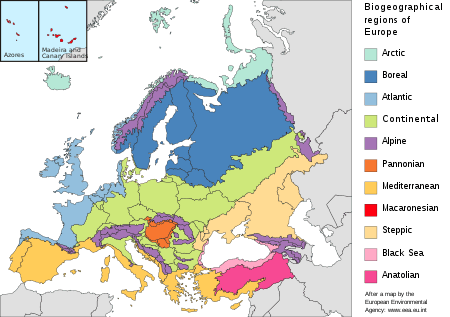
Glaciation during the most recent ice age and the presence of man affected the distribution of European fauna. As for the animals, in many parts of Europe most large animals and top predator species have been hunted to extinction. The woolly mammoth was extinct before the end of the Neolithic period. Today wolves (carnivores) and bears (omnivores) are endangered. Once they were found in most parts of Europe. However, deforestation and hunting caused these animals to withdraw further and further. By the Middle Ages the bears' habitats were limited to more or less inaccessible mountains with sufficient forest cover. Today, the brown bear lives primarily in the Balkan peninsula, Scandinavia, and Russia; a small number also persist in other countries across Europe (Austria, Pyrenees etc.), but in these areas brown bear populations are fragmented and marginalised because of the destruction of their habitat. In addition, polar bears may be found on Svalbard, a Norwegian archipelago far north of Scandinavia. The wolf, the second largest predator in Europe after the brown bear, can be found primarily in Central and Eastern Europe and in the Balkans, with a handful of packs in pockets of Western Europe (Scandinavia, Spain, etc.).
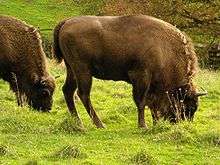
European wild cat, foxes (especially the red fox), jackal and different species of martens, hedgehogs, different species of reptiles (like snakes such as vipers and grass snakes) and amphibians, different birds (owls, hawks and other birds of prey).
Important European herbivores are snails, larvae, fish, different birds, and mammals, like rodents, deer and roe deer, boars, and living in the mountains, marmots, steinbocks, chamois among others. A number of insects, such as the small tortoiseshell butterfly, add to the biodiversity.[239]
The extinction of the dwarf hippos and dwarf elephants has been linked to the earliest arrival of humans on the islands of the Mediterranean.[240]
Sea creatures are also an important part of European flora and fauna. The sea flora is mainly phytoplankton. Important animals that live in European seas are zooplankton, molluscs, echinoderms, different crustaceans, squids and octopuses, fish, dolphins, and whales.
Biodiversity is protected in Europe through the Council of Europe's Bern Convention, which has also been signed by the European Community as well as non-European states.
Politics
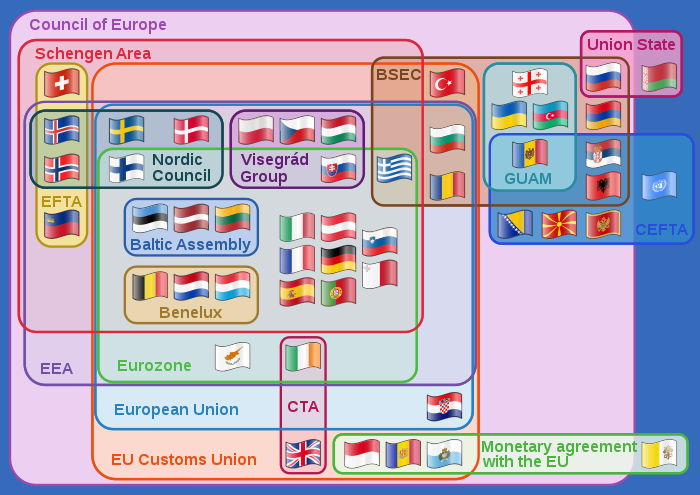
The political map of Europe is substantially derived from the re-organisation of Europe following the Napoleonic Wars in 1815. The prevalent form of government in Europe is parliamentary democracy, in most cases in the form of Republic; in 1815, the prevalent form of government was still the Monarchy. Europe's remaining eleven monarchies[241] are constitutional.
European integration is the process of political, legal, economic (and in some cases social and cultural) integration of European states as it has been pursued by the powers sponsoring the Council of Europe since the end of World War II The European Union has been the focus of economic integration on the continent since its foundation in 1993. More recently, the Eurasian Economic Union has been established as a counterpart comprising former Soviet states.
27 European states are members of the politico-economic European Union, 26 of the border-free Schengen Area and 19 of the monetary union Eurozone. Among the smaller European organisations are the Nordic Council, the Benelux, the Baltic Assembly and the Visegrád Group.
List of states and territories
The list below includes all entities falling even partially under any of the various common definitions of Europe, geographically or politically.
| Flag[242] | Arms | Name | Area (km2) |
Population |
Population density (per km2) |
Capital | Name(s) in official language(s) |
|---|---|---|---|---|---|---|---|
| Albania | 28,748 | 2,876,591 | 98.5 | Tirana | Shqipëria | ||
| Andorra | 468 | 77,281 | 179.8 | Andorra la Vella | Andorra | ||
| Armenia [j] | 29,743 | 2,924,816 | 101.5 | Yerevan | Հայաստան (Hayastan) | ||
| Austria | 83,858 | 8,823,054 | 104 | Vienna | Österreich | ||
| Azerbaijan [k] | 86,600 | 9,911,646 | 113 | Baku | Azǝrbaycan | ||
| Belarus | 207,560 | 9,504,700 | 45.8 | Minsk | Беларусь (Belaruś) | ||
| Belgium | 30,528 | 11,358,357 | 372.06 | Brussels | België/Belgique/Belgien | ||
| Bosnia and Herzegovina | 51,129 | 3,531,159 | 68.97 | Sarajevo | Bosna i Hercegovina/Боснa и Херцеговина | ||
| Bulgaria | 110,910 | 7,101,859 | 64.9 | Sofia | България (Bǎlgariya) | ||
| Croatia | 56,542 | 4,284,889 | 75.8 | Zagreb | Hrvatska | ||
| Cyprus [d] | 9,251 | 1,170,125 | 123.4 | Nicosia | Kýpros/Kıbrıs | ||
| Czech Republic | 78,866 | 10,610,947 | 134 | Prague | Česko | ||
| Denmark | 43,094 | 5,748,796 | 133.9 | Copenhagen | Danmark | ||
| Estonia | 45,226 | 1,319,133 | 28 | Tallinn | Eesti | ||
| Finland | 336,593 | 5,509,717 | 16 | Helsinki | Suomi/Finland | ||
| France [g] | 547,030 | 67,348,000 | 116 | Paris | France | ||
| Georgia [l] | 69,700 | 3,718,200 | 53.5 | Tbilisi | საქართველო (Sakartvelo) | ||
| Germany | 357,168 | 82,800,000 | 232 | Berlin | Deutschland | ||
| Greece | 131,957 | 10,768,477 | 82 | Athens | Ελλάδα (Elláda) | ||
| Hungary | 93,030 | 9,797,561 | 105.3 | Budapest | Magyarország | ||
| Iceland | 103,000 | 350,710 | 3.2 | Reykjavík | Ísland | ||
| Ireland | 70,280 | 4,761,865 | 67.7 | Dublin | Éire/Ireland | ||
| Italy | 301,338 | 60,589,445 | 201.3 | Rome | Italia | ||
| Kazakhstan [i] | 2,724,900 | 17,987,736 | 6.49 | Nur-Sultan | Қазақстан (Qazaqstan) | ||
| Latvia | 64,589 | 1,925,800 | 34.3 | Riga | Latvija | ||
| Liechtenstein | 160 | 38,111 | 227 | Vaduz | Liechtenstein | ||
| Lithuania | 65,300 | 2,800,667 | 45.8 | Vilnius | Lietuva | ||
| Luxembourg | 2,586 | 602,005 | 233.7 | Luxembourg | Lëtzebuerg/Luxemburg/Luxembourg | ||
| Malta | 316 | 445,426 | 1,410 | Valletta | Malta | ||
| Moldova [a] | 33,846 | 4,434,547 | 131.0 | Chișinău | Moldova | ||
| Monaco | 2.020 | 38,400 | 18,713 | Monaco | Monaco | ||
| Montenegro | 13,812 | 642,550 | 45.0 | Podgorica | Crna Gora/Црна Гора | ||
| Netherlands [h] | 41,543 | 17,271,990 | 414.9 | Amsterdam | Nederland | ||
| North Macedonia | 25,713 | 2,103,721 | 80.1 | Skopje | Северна Македонија (Severna Makedonija) | ||
| Norway | 385,203 | 5,295,619 | 15.8 | Oslo | Norge/Noreg/Norga | ||
| Poland | 312,685 | 38,422,346 | 123.5 | Warsaw | Polska | ||
| Portugal [e] | 92,212 | 10,379,537 | 115 | Lisbon | Portugal | ||
| Romania | 238,397 | 19,638,000 | 84.4 | Bucharest | România | ||
| Russia [b] | 17,098,246 | 144,526,636 | 8.4 | Moscow | Россия (Rossiya) | ||
| San Marino | 61.2 | 33,285 | 520 | San Marino | San Marino | ||
| Serbia [f] | 88,361 | 7,040,272 | 91.1 | Belgrade | Srbija/Србија | ||
| Slovakia | 49,035 | 5,435,343 | 111.0 | Bratislava | Slovensko | ||
| Slovenia | 20,273 | 2,066,880 | 101.8 | Ljubljana | Slovenija | ||
| Spain | 505,990 | 46,698,151 | 92 | Madrid | España | ||
| Sweden | 450,295 | 10,151,588 | 22.5 | Stockholm | Sverige | ||
| Switzerland | 41,285 | 8,401,120 | 202 | Bern | Schweiz/Suisse/Svizzera/Svizra | ||
| Turkey [m] | 783,356 | 80,810,525 | 105 | Ankara | Türkiye | ||
| Ukraine | 603,628 | 42,418,235 | 73.8 | Kiev | Україна (Ukraina) | ||
| United Kingdom | 244,820 | 66,040,229 | 270.7 | London | United Kingdom | ||
| Vatican City | 0.44 | 1,000 | 2,272 | Vatican City | Città del Vaticano/Civitas Vaticana | ||
| Total | 50 | 10,180,000[n] | 743,000,000[n] | 73 | |||
Within the above-mentioned states are several de facto independent countries with limited to no international recognition. None of them are members of the UN:
| Flag | Symbol | Name | Area (km²) |
Population |
Population density (per km²) |
Capital |
|---|---|---|---|---|---|---|
| Abkhazia [p] | 8,660 | 243,206 | 28 | Sukhumi | ||
| Artsakh [q] | 11,458 | 150,932 | 12 | Stepanakert | ||
| Kosovo [o] | 10,908 | 1,920,079 | 159 | Pristina | ||
| Northern Cyprus [d] | 3,355 | 313,626 | 93 | Nicosia | ||
| South Ossetia [p] | 3,900 | 53,532 | 13.7 | Tskhinvali | ||
| Transnistria [a] | 4,163 | 475,665 | 114 | Tiraspol |
Several dependencies and similar territories with broad autonomy are also found within or in close proximity to Europe. This includes Åland (a region of Finland), two constituent countries of the Kingdom of Denmark (other than Denmark itself), three Crown dependencies, and two British Overseas Territories. Svalbard is also included due to its unique status within Norway, although it is not autonomous. Not included are the three countries of the United Kingdom with devolved powers and the two Autonomous Regions of Portugal, which despite having a unique degree of autonomy, are not largely self-governing in matters other than international affairs. Areas with little more than a unique tax status, such as Heligoland and the Canary Islands, are also not included for this reason.
| Flag | Symbol | Name | Sovereign state |
Area (km²) |
Population | Population density (per km²) |
Capital |
|---|---|---|---|---|---|---|---|
| Sovereign Base Areas of Akrotiri and Dhekelia | UK | 254 | 15,700 | 59.1 | Episkopi Cantonment | ||
| Åland | Finland | 13,517 | 29,489 | 18.36 | Mariehamn | ||
| Bailiwick of Guernsey [c] | UK | 78 | 65,849 | 844.0 | St. Peter Port | ||
| Bailiwick of Jersey [c] | UK | 118.2 | 100,080 | 819 | Saint Helier | ||
| Faroe Islands | Denmark | 1,399 | 50,778 | 35.2 | Tórshavn | ||
| Gibraltar | UK | 6.7 | 32,194 | 4,328 | Gibraltar | ||
| Greenland | Denmark [r] | 2,166,086 | 55,877 | 0.028 | Nuuk | ||
| Isle of Man [c] | UK | 572 | 83,314 | 148 | Douglas | ||
| Svalbard | Norway | 61,022 | 2,667 | 0.044 | Longyearbyen |
Economy
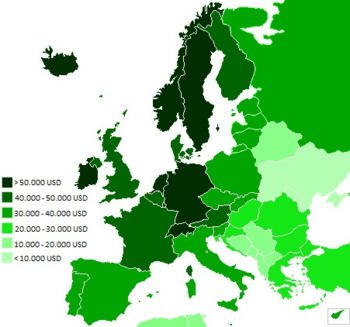
As a continent, the economy of Europe is currently the largest on Earth and it is the richest region as measured by assets under management with over $32.7 trillion compared to North America's $27.1 trillion in 2008.[243] In 2009 Europe remained the wealthiest region. Its $37.1 trillion in assets under management represented one-third of the world's wealth. It was one of several regions where wealth surpassed its precrisis year-end peak.[244] As with other continents, Europe has a large variation of wealth among its countries. The richer states tend to be in the West; some of the Central and Eastern European economies are still emerging from the collapse of the Soviet Union and the breakup of Yugoslavia.
The European Union, a political entity composed of 28 European states, comprises the largest single economic area in the world. 19 EU countries share the euro as a common currency. Five European countries rank in the top ten of the world's largest national economies in GDP (PPP). This includes (ranks according to the CIA): Germany (6), Russia (7), the United Kingdom (10), France (11), and Italy (13).[245]
There is huge disparity between many European countries in terms of their income. The richest in terms of GDP per capita is Monaco with its US$172,676 per capita (2009) and the poorest is Moldova with its GDP per capita of US$1,631 (2010).[246] Monaco is the richest country in terms of GDP per capita in the world according to the World Bank report.
As a whole, Europe's GDP per capita is US$21,767 according to a 2016 International Monetary Fund assessment.[247]
| Rank | Country | GDP (nominal, Peak Year) millions of USD |
Peak Year |
|---|---|---|---|
| – | 19,226,235 | 2008 | |
| 1 | 3,982,235 | 2020 | |
| 2 | 3,085,300 | 2007 | |
| 3 | 2,929,983 | 2008 | |
| 4 | 2,400,232 | 2008 | |
| 5 | 2,292,464 | 2013 | |
| 6 | 1,641,514 | 2008 | |
| 7 | 951,766 | 2008 | |
| 8 | 950,328 | 2013 | |
| 9 | 749,424 | 2020 | |
| 10 | 606,730 | 2020 |
| Rank | Country | GDP (PPP, Peak Year) millions of USD |
Peak Year |
|---|---|---|---|
| – | 22,825,236 | 2019 | |
| 1 | 4,443,569 | 2019 | |
| 2 | 4,389,960 | 2019 | |
| 3 | 3,162,408 | 2019 | |
| 4 | 3,061,815 | 2019 | |
| 5 | 2,454,809 | 2019 | |
| 6 | 2,361,778 | 2019 | |
| 7 | 1,923,646 | 2019 | |
| 8 | 1,287,275 | 2019 | |
| 9 | 1,005,337 | 2019 | |
| 10 | 572,902 | 2019 |
Economic history
- Industrial growth (1760–1945)
Capitalism has been dominant in the Western world since the end of feudalism.[248] From Britain, it gradually spread throughout Europe.[249] The Industrial Revolution started in Europe, specifically the United Kingdom in the late 18th century,[250] and the 19th century saw Western Europe industrialise. Economies were disrupted by World War I but by the beginning of World War II they had recovered and were having to compete with the growing economic strength of the United States. World War II, again, damaged much of Europe's industries.
- Cold War (1945–1991)
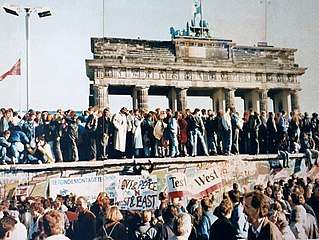
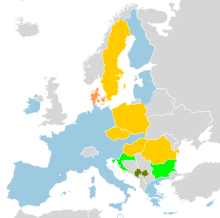
After World War II the economy of the UK was in a state of ruin,[251] and continued to suffer relative economic decline in the following decades.[252] Italy was also in a poor economic condition but regained a high level of growth by the 1950s. West Germany recovered quickly and had doubled production from pre-war levels by the 1950s.[253] France also staged a remarkable comeback enjoying rapid growth and modernisation; later on Spain, under the leadership of Franco, also recovered, and the nation recorded huge unprecedented economic growth beginning in the 1960s in what is called the Spanish miracle.[254] The majority of Central and Eastern European states came under the control of the Soviet Union and thus were members of the Council for Mutual Economic Assistance (COMECON).[255]
The states which retained a free-market system were given a large amount of aid by the United States under the Marshall Plan.[256] The western states moved to link their economies together, providing the basis for the EU and increasing cross border trade. This helped them to enjoy rapidly improving economies, while those states in COMECON were struggling in a large part due to the cost of the Cold War. Until 1990, the European Community was expanded from 6 founding members to 12. The emphasis placed on resurrecting the West German economy led to it overtaking the UK as Europe's largest economy.
- Reunification (1991–present)
With the fall of communism in Central and Eastern Europe in 1991, the post-socialist states began free market reforms.
After East and West Germany were reunited in 1990, the economy of West Germany struggled as it had to support and largely rebuild the infrastructure of East Germany.
By the millennium change, the EU dominated the economy of Europe comprising the five largest European economies of the time namely Germany, the United Kingdom, France, Italy, and Spain. In 1999, 12 of the 15 members of the EU joined the Eurozone replacing their former national currencies by the common euro. The three who chose to remain outside the Eurozone were: the United Kingdom, Denmark, and Sweden. The European Union is now the largest economy in the world.[257]
Figures released by Eurostat in 2009 confirmed that the Eurozone had gone into recession in 2008.[258] It impacted much of the region.[259] In 2010, fears of a sovereign debt crisis[260] developed concerning some countries in Europe, especially Greece, Ireland, Spain, and Portugal.[261] As a result, measures were taken, especially for Greece, by the leading countries of the Eurozone.[262] The EU-27 unemployment rate was 10.3% in 2012.[263] For those aged 15–24 it was 22.4%.[263]
Demographics
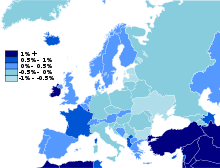
In 2017, the population of Europe was estimated to be 742 million according to the 2019 revision of the World Population Prospects[2][3], which is slightly more than one-ninth of the world's population. This number includes Siberia, (about 38 million people) but excludes European Turkey (about 12 million).
A century ago, Europe had nearly a quarter of the world's population.[265] The population of Europe has grown in the past century, but in other areas of the world (in particular Africa and Asia) the population has grown far more quickly.[266] Among the continents, Europe has a relatively high population density, second only to Asia. Most of Europe is in a mode of Sub-replacement fertility, which means that each new(-born) generation is being less populous than the older. The most densely populated country in Europe (and in the world) is the microstate of Monaco.
Ethnic groups
Pan and Pfeil (2004) count 87 distinct "peoples of Europe", of which 33 form the majority population in at least one sovereign state, while the remaining 54 constitute ethnic minorities.[267]
According to UN population projection, Europe's population may fall to about 7% of world population by 2050, or 653 million people (medium variant, 556 to 777 million in low and high variants, respectively).[266] Within this context, significant disparities exist between regions in relation to fertility rates. The average number of children per female of child-bearing age is 1.52.[268] According to some sources,[269] this rate is higher among Muslims in Europe. The UN predicts a steady population decline in Central and Eastern Europe as a result of emigration and low birth rates.[270]

Migration
Europe is home to the highest number of migrants of all global regions at 70.6 million people, the IOM's report said.[271] In 2005, the EU had an overall net gain from immigration of 1.8 million people. This accounted for almost 85% of Europe's total population growth.[272] In 2008, 696,000 persons were given citizenship of an EU27 member state, a decrease from 707,000 the previous year.[273] In 2017, approximately 825,000 persons acquired citizenship of an EU28 member state.[274] 2.4 million immigrants from non-EU countries entered the EU in 2017.[275]
Early modern emigration from Europe began with Spanish and Portuguese settlers in the 16th century,[276][277] and French and English settlers in the 17th century.[278] But numbers remained relatively small until waves of mass emigration in the 19th century, when millions of poor families left Europe.[279]
Today, large populations of European descent are found on every continent. European ancestry predominates in North America, and to a lesser degree in South America (particularly in Uruguay, Argentina, Chile and Brazil, while most of the other Latin American countries also have a considerable population of European origins). Australia and New Zealand have large European derived populations. Africa has no countries with European-derived majorities (or with the exception of Cape Verde and probably São Tomé and Príncipe, depending on context), but there are significant minorities, such as the White South Africans in South Africa. In Asia, European-derived populations, (specifically Russians), predominate in North Asia and some parts of Northern Kazakhstan.[280]
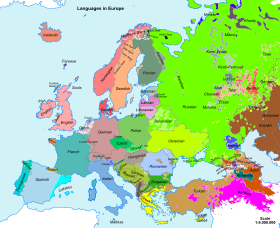
Languages
Europe has about 225 indigenous languages,[281] mostly falling within three Indo-European language groups: the Romance languages, derived from the Latin of the Roman Empire; the Germanic languages, whose ancestor language came from southern Scandinavia; and the Slavic languages.[233] Slavic languages are mostly spoken in Southern, Central and Eastern Europe. Romance languages are spoken primarily in Western and Southern Europe as well as in Switzerland in Central Europe and Romania and Moldova in Eastern Europe. Germanic languages are spoken in Western, Northern and Central Europe as well as in Gibraltar and Malta in Southern Europe.[233] Languages in adjacent areas show significant overlaps (such as in English, for example). Other Indo-European languages outside the three main groups include the Baltic group (Latvian and Lithuanian), the Celtic group (Irish, Scottish Gaelic, Manx, Welsh, Cornish, and Breton[233]), Greek, Armenian, and Albanian.
A distinct non-Indo-European family of Uralic languages (Estonian, Finnish, Hungarian, Erzya, Komi, Mari, Moksha, and Udmurt) is spoken mainly in Estonia, Finland, Hungary, and parts of Russia. Turkic languages include Azerbaijani, Kazakh and Turkish, in addition to smaller languages in Eastern and Southeast Europe (Balkan Gagauz Turkish, Bashkir, Chuvash, Crimean Tatar, Karachay-Balkar, Kumyk, Nogai, and Tatar). Kartvelian languages (Georgian, Mingrelian, and Svan) are spoken primarily in Georgia. Two other language families reside in the North Caucasus (termed Northeast Caucasian, most notably including Chechen, Avar, and Lezgin; and Northwest Caucasian, most notably including Adyghe). Maltese is the only Semitic language that is official within the EU, while Basque is the only European language isolate.
Multilingualism and the protection of regional and minority languages are recognised political goals in Europe today. The Council of Europe Framework Convention for the Protection of National Minorities and the Council of Europe's European Charter for Regional or Minority Languages set up a legal framework for language rights in Europe.
Major cities
The four largest cities of Europe are Istanbul, Moscow, Paris and London, each have over 10 million residents,[8] and as such have been described as megacities.[282] While Istanbul has the highest total population, one third lies on the Asian side of the Bosporus, making Moscow the most populous city entirely in Europe. The next largest cities in order of population are Saint Petersburg, Madrid, Berlin and Rome, each having over 3 million residents.[8]
When considering the commuter belts or metropolitan areas, within the EU (for which comparable data is available) London covers the largest population, followed in order by Paris, Madrid, Barcelona, Berlin, the Ruhr area, Rome, Milan, Athens and Warsaw.[283]
Culture
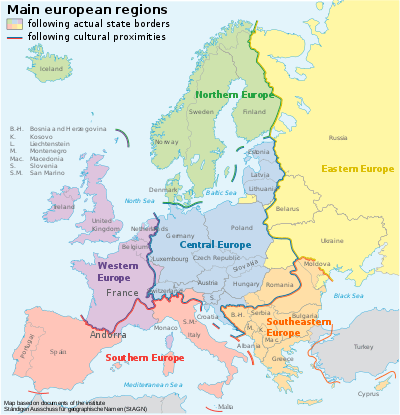
"Europe" as a cultural concept is substantially derived from the shared heritage of the Roman Empire and its culture.
The boundaries of Europe were historically understood as those of Christendom (or more specifically Latin Christendom), as established or defended throughout the medieval and early modern history of Europe, especially against Islam, as in the Reconquista and the Ottoman wars in Europe.[284]
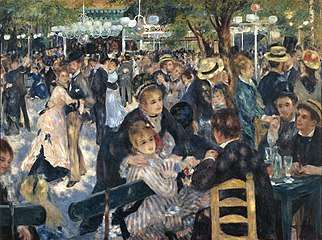
This shared cultural heritage is combined by overlapping indigenous national cultures and folklores, roughly divided into Slavic, Latin (Romance) and Germanic, but with several components not part of either of these group (notably Greek and Celtic).
Cultural contact and mixtures characterise much of European regional cultures; Kaplan (2014) describes Europe as "embracing maximum cultural diversity at minimal geographical distances".[285]
Different cultural events are organised in Europe, with the aim of bringing different cultures closer together and raising awareness of their importance, such as the European Capital of Culture, the European Region of Gastronomy, the European Youth Capital and the European Capital of Sport.
Religion
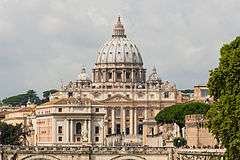
Historically, religion in Europe has been a major influence on European art, culture, philosophy and law. There are six patron saints of Europe venerated in Roman Catholicism, five of them so declared by Pope John Paul II between 1980–1999: Saints Cyril and Methodius, Saint Bridget of Sweden, Catherine of Siena and Saint Teresa Benedicta of the Cross (Edith Stein). The exception is Benedict of Nursia, who had already been declared "Patron Saint of all Europe" by Pope Paul VI in 1964.[286]
The largest religion in Europe is Christianity, with 76.2% of Europeans considering themselves Christians,[288] including Catholic, Eastern Orthodox and various Protestant denominations. Among Protestants, the most popular are historically state-supported European denominations such as Lutheranism, Anglicanism and the Reformed faith. Other Protestant denominations such as historically significant ones like Anabaptists were never supported by any state and thus are not so widespread, as well as these newly arriving from the United States such as Pentecostalism, Adventism, Methodism, Baptists and various Evangelical Protestants; although Methodism and Baptists both have European origins. The notion of "Europe" and the "Western World" has been intimately connected with the concept of "Christianity and Christendom"; many even attribute Christianity for being the link that created a unified European identity.[289]
Christianity, including the Roman Catholic Church,[290][291] has played a prominent role in the shaping of Western civilisation since at least the 4th century,[292][293][294][295] and for at least a millennium and a half, Europe has been nearly equivalent to Christian culture, even though the religion was inherited from the Middle East. Christian culture was the predominant force in western civilisation, guiding the course of philosophy, art, and science.[296][297]
The second most popular religion is Islam (6%)[298] concentrated mainly in the Balkans and Eastern Europe (Bosnia and Herzegovina, Albania, Kosovo, Kazakhstan, North Cyprus, Turkey, Azerbaijan, North Caucasus, and the Volga-Ural region). Other religions, including Judaism, Hinduism, and Buddhism are minority religions (though Tibetan Buddhism is the majority religion of Russia's Republic of Kalmykia). The 20th century saw the revival of Neopaganism through movements such as Wicca and Druidry.
Europe has become a relatively secular continent, with an increasing number and proportion of irreligious, atheist and agnostic people, who make up about 18.2% of Europe's population,[299] currently the largest secular population in the Western world. There are a particularly high number of self-described non-religious people in the Czech Republic, Estonia, Sweden, former East Germany, and France.[300]
Sport
Sport in Europe tends to be highly organized with many sports having professional leagues.
The origins of many of the world's most popular sports today lie in the codification of many traditional games, especially in Great Britain. However, a paradoxical feature of European sport is the remarkable extent to which local, regional and national variations continue to exist, and even in some instances to predominate.[301]See also
- History
- Genetic History of Europe
- Prehistoric Europe
- Classical antiquity
- Middle Ages
- Early modern Europe
- Modernity
- History of Europe
- Politics
- Eurodistrict
- Euroregion
- Flags of Europe
- List of sovereign states by date of formation
- Names of European cities in different languages
- OSCE countries statistics
- European Union as a potential superpower
- Demographics
- Area and population of European countries
- European Union statistics
- List of European cities by population within city limits
- Largest cities of the EU
- Largest urban areas of the European Union
- List of cities in Europe
- List of metropolitan areas in Europe
- List of villages in Europe
- Pan-European identity
- Economics
- Economy of the European Union
- Financial and social rankings of European countries
- Healthcare in Europe
- Telecommunications in Europe
- List of European television stations
- List of European countries by GDP (nominal)
- Culture
- European Capital of Culture
- European Region of Gastronomy
- European Youth Capital
- European Capital of Sport
- Sports
Notes
- ^ a b Transnistria, internationally recognised as being a legal part of the Republic of Moldova, although de facto control is exercised by its internationally unrecognised government which declared independence from Moldova in 1990.
- ^ Russia is a transcontinental country located in Eastern Europe and Northern Asia, but is considered European historically, culturally, ethnically, and politically, and the vast majority of its population (78%) lives in the European part of the country.
- ^ a b c Guernsey, the Isle of Man and Jersey are Crown Dependencies of the United Kingdom. Other Channel Islands legislated by the Bailiwick of Guernsey include Alderney and Sark.
- ^ a b Cyprus can be considered part of Europe or Southwest Asia; it has strong historical and sociopolitical connections with Europe. The population and area figures refer to the entire state, including the de facto independent part Northern Cyprus which is not recognised as a sovereign nation by the vast majority of sovereign nations, nor the UN.
- ^
- ^
- ^ Figures for France include only metropolitan France: some politically integral parts of France are geographically located outside Europe.
- ^ Netherlands population for November 2014. Population and area details include European portion only: Netherlands and three entities outside Europe (Aruba, Curaçao and Sint Maarten, in the Caribbean) constitute the Kingdom of the Netherlands. Amsterdam is the official capital, while The Hague is the administrative seat.
- ^ Kazakhstan is physiographically considered a transcontinental country, mostly in Central Asia (UN region), partly in Eastern Europe, with European territory west of the Ural Mountains and Ural River. However, only the population figure refers to the entire country.
- ^ Armenia can be considered part of Eastern Europe or Western Asia; it has strong historical and sociopolitical connections with Europe. The population and area figures include the entire state respectively.
- ^ Azerbaijan can be considered part of Europe or Western Asia.[302] However the population and area figures are for the entire state. This includes the exclave of the Nakhchivan Autonomous Republic and the region Nagorno-Karabakh that has declared, and de facto achieved, independence. Nevertheless, it is not recognised de jure by sovereign states.
- ^ Georgia can be considered part of Eastern Europe or West Asia; it has strong historical and sociopolitical connections with Europe.[303] The population and area figures include Georgian estimates for Abkhazia and South Ossetia, two regions that have declared and de facto achieved independence. International recognition, however, is limited.
- ^
- ^ a b c d The total figures for area and population include only European portions of transcontinental countries. The precision of these figures is compromised by the ambiguous geographical extent of Europe and the lack of references for European portions of transcontinental countries.
- ^
- ^ a b Abkhazia and South Ossetia, both of which can be considered part of Eastern Europe or West Asia[305] unilaterally declared their independence from Georgia on 25 August 1990 and 28 November 1991 respectively. Their status as sovereign nations is not recognised by a vast majority of sovereign nations, nor the UN. Population figures stated as of 2003 census and 2000 estimates respectively.
- ^ Nagorno-Karabakh, which can be considered part of Eastern Europe or West Asia, unilaterally declared its independence from Azerbaijan on 6 January 1992. Its status as a sovereign nation is not recognised by any sovereign nation, nor the UN. Population figures stated as of 2003 census and 2000 estimates respectively.
- ^ Greenland, an autonomous constituent country within the Danish Realm, is geographically a part of the continent of North America, but has been politically and culturally associated with Europe.
References
- "Largest Countries In Europe 2019".
- ""World Population prospects – Population division"". population.un.org. United Nations Department of Economic and Social Affairs, Population Division. Retrieved 9 November 2019.
- ""Overall total population" – World Population Prospects: The 2019 Revision" (xslx). population.un.org (custom data acquired via website). United Nations Department of Economic and Social Affairs, Population Division. Retrieved 9 November 2019.
- "GDP PPP, current prices". International Monetary Fund. 2019. Retrieved 20 April 2019.
- "GDP Nominal, current prices". International Monetary Fund. 2019. Retrieved 6 March 2019.
- "Nominal GDP per capita". International Monetary Fund. 2019. Retrieved 20 April 2019.
- "Reports – Human Development Reports". hdr.undp.org. Archived from the original on 9 July 2012. Retrieved 21 July 2017.
- "The World's Cities in 2016" (PDF). United Nations. 2016. p. 11.
- National Geographic Atlas of the World (7th ed.). Washington, DC: National Geographic. 1999. ISBN 978-0-7922-7528-2. "Europe" (pp. 68–69); "Asia" (pp. 90–91): "A commonly accepted division between Asia and Europe ... is formed by the Ural Mountains, Ural River, Caspian Sea, Caucasus Mountains, and the Black Sea with its outlets, the Bosporus and Dardanelles."
- Lewis & Wigen 1997, p. 226
- Kim Covert (2011). Ancient Greece: Birthplace of Democracy. Capstone. p. 5. ISBN 978-1-4296-6831-6.
Ancient Greece is often called the cradle of western civilization. ... Ideas from literature and science also have their roots in ancient Greece.
- Ricardo Duchesne (2011). The Uniqueness of Western Civilization. Brill. p. 297. ISBN 978-90-04-19248-5.
The list of books which have celebrated Greece as the "cradle" of the West is endless; two more examples are Charles Freeman's The Greek Achievement: The Foundation of the Western World (1999) and Bruce Thornton's Greek Ways: How the Greeks Created Western Civilization (2000)
- National Geographic, 534.
- "The European union—a federation or a confederation?" (PDF).
- M. L. West; Morris West (24 May 2007). Indo-European Poetry and Myth. OUP Oxford. p. 185. ISBN 978-0-19-928075-9.
- Charles FitzRoy (26 February 2015). The Rape of Europa: The Intriguing History of Titian's Masterpiece. Bloomsbury Publishing. pp. 52–. ISBN 978-1-4081-9211-5.
- Michael C. Astour (1967). Hellenosemitica: An Ethnic and Cultural Study in West Semitic Impact on Mycenaean Greece. Brill Archive. p. 128. GGKEY:G19ZZ3TSL38.
- Beekes, Robert (2004). "Kadmos and Europa, and the Phoenicians" (PDF). Kadmos. 43 (1): 168–69. doi:10.1515/kadm.43.1.167.
- "Europe" in the Online Etymology Dictionary.
- Michael A. Barry: "L'Europe et son mythe : à la poursuite du couchant". In: Revue des deux Mondes (November/December 1999) p. 110. ISBN 978-2-7103-0937-6.
- M.L. West (1997). The east face of Helicon: west Asiatic elements in Greek poetry and myth. Oxford: Clarendon Press. p. 451. ISBN 978-0-19-815221-7..
- Davidson, Roderic H. (1960). "Where is the Middle East?". Foreign Affairs. 38 (4): 665–675. doi:10.2307/20029452. JSTOR 20029452. S2CID 157454140.CS1 maint: ref=harv (link)
- The map shows one of the most commonly accepted delineations of the geographical boundaries of Europe, as used by National Geographic and Encyclopædia Britannica. Whether countries are considered in Europe or Asia can vary in sources, for example in the classification of the CIA World Factbook or that of the BBC. Certain countries in Europe, such as France, have territories lying geographically outside Europe, but which are nevertheless considered integral parts of that country.
- Microsoft Encarta Online Encyclopaedia 2007. Europe. Archived from the original on 28 October 2009. Retrieved 27 December 2007.
- Falconer, William; Falconer, Thomas. Dissertation on St. Paul's Voyage, BiblioLife (BiblioBazaar), 1872. (1817.), p. 50, ISBN 1-113-68809-2 These islands Pliny, as well as Strabo and Ptolemy, included in the African sea
- "Europe — Noun". Princeton University. Retrieved 9 June 2008.
- Histories 4.38. C.f. James Rennell, The geographical system of Herodotus examined and explained, Volume 1, Rivington 1830, p. 244
- Herodotus, 4:45
- Strabo Geography 11.1
- Franxman, Thomas W. (1979). Genesis and the Jewish antiquities of Flavius Josephus. Pontificium Institutum Biblicum. pp. 101–102. ISBN 978-88-7653-335-8.
- W. Theiler, Posidonios. Die Fragmente, vol. 1. Berlin: De Gruyter, 1982, fragm. 47a.
- I. G. Kidd (ed.), Posidonius: The commentary, Cambridge University Press, 2004, ISBN 978-0-521-60443-7, p. 738.
- Geographia 7.5.6 (ed. Nobbe 1845, vol. 2, p. 178) Καὶ τῇ Εὐρώπῃ δὲ συνάπτει διὰ τοῦ μεταξὺ αὐχένος τῆς τε Μαιώτιδος λίμνης καὶ τοῦ Σαρματικοῦ Ὠκεανοῦ ἐπὶ τῆς διαβάσεως τοῦ Τανάϊδος ποταμοῦ. "And [Asia] is connected to Europe by the land-strait between Lake Maiotis and the Sarmatian Ocean where the river Tanais crosses through."
- Norman F. Cantor, The Civilization of the Middle Ages, 1993, ""Culture and Society in the First Europe", pp185ff.
- Noted by Cantor, 1993:181.
- Philipp Johann von Strahlenberg (1730). Das Nord-und Ostliche Theil von Europa und Asia (in German). p. 106.
- Davies, Norman (1996). Europe: A History. p. 8. ISBN 978-0-19-820171-7. Retrieved 23 August 2010.
- "Boundary of Europe and Asia along Urals" (in Russian). Archived from the original on 8 January 2012.
- Peter Simon Pallas, Journey through various provinces of the Russian Empire, vol. 3 (1773)
- Douglas W. Freshfield, "Journey in the Caucasus", Proceedings of the Royal Geographical Society, Volumes 13–14, 1869. Cited as de facto convention by Baron von Haxthausen, Transcaucasia (1854); review Dublin University Magazine
- "Europe", Brockhaus and Efron Encyclopedic Dictionary, 1906
- "Do we live in Europe or in Asia?" (in Russian).
- Orlenok V. (1998). "Physical Geography" (in Russian). Archived from the original on 16 October 2011.
- E.M. Moores, R.W. Fairbridge, Encyclopedia of European and Asian regional geology, Springer, 1997, ISBN 978-0-412-74040-4, p. 34: "most Soviet geographers took the watershed of the Main Range of the Greater Caucasus as the boundary between Europe and Asia."
- A. Vekua; D. Lordkipanidze; G.P. Rightmire; J. Agusti; R. Ferring; G. Maisuradze; et al. (2002). "A new skull of early Homo from Dmanisi, Georgia". Science. 297 (5578): 85–89. Bibcode:2002Sci...297...85V. doi:10.1126/science.1072953. PMID 12098694. S2CID 32726786.CS1 maint: ref=harv (link)
- The million year old tooth from Atapuerca, Spain, found in June 2007
- http://cnn.it/2yDM2Lx
- National Geographic, 21.
- Fu, Qiaomei; et al. (23 October 2014). "The genome sequence of a 45,000-year-old modern human from western Siberia". Nature. 514 (7523): 445–449. Bibcode:2014Natur.514..445F. doi:10.1038/nature13810. hdl:10550/42071. PMC 4753769. PMID 25341783.
- 42.7–41.5 ka (1σ CI). Douka, Katerina; et al. (2012). "A new chronostratigraphic framework for the Upper Palaeolithic of Riparo Mochi (Italy)". Journal of Human Evolution. 62 (2): 286–299. doi:10.1016/j.jhevol.2011.11.009. PMID 22189428.
- Borza, E.N. (1992), In the Shadow of Olympus: The Emergence of Macedon, Princeton University Press, p. 58, ISBN 978-0691008806
- Scarre, Chris (1996). Fagan, Brian M. (ed.). The Oxford Companion to Archaeology. Oxford University Press. pp. 215–216. ISBN 978-0-19-507618-9.CS1 maint: ref=harv (link)
- Atkinson, R.J.C., Stonehenge (Penguin Books, 1956)
- Peregrine, Peter Neal; Ember, Melvin, eds. (2001). "European Megalithic". Encyclopedia of Prehistory. 4 : Europe. Springer. pp. 157–184. ISBN 978-0-306-46258-0.
- "Ancient Greece". British Museum. Archived from the original on 15 June 2012.
- "Periods – School of Archaeology". University of Oxford. Archived from the original on 19 November 2018. Retrieved 25 December 2018.
- Short, John R. (1987), An Introduction to Urban Geography, Routledge, p. 10, ISBN 978-0710203724
- Jonathan Daly (2013). The Rise of Western Power: A Comparative History of Western Civilization. A&C Black. pp. 7–9. ISBN 978-1-4411-1851-6.
- Dunn, John (1994), Democracy: the unfinished journey 508 BC – 1993 AD, Oxford University Press, ISBN 978-0-19-827934-1
- National Geographic, 76.
- Heath, Thomas Little (1981). A History of Greek Mathematics, Volume I. Dover Publications. ISBN 978-0-486-24073-2.CS1 maint: ref=harv (link)
- Heath, Thomas Little (1981). A History of Greek Mathematics, Volume II. Dover publications. ISBN 978-0-486-24074-9.CS1 maint: ref=harv (link)
- Pedersen, Olaf. Early Physics and Astronomy: A Historical Introduction. 2nd edition. Cambridge: Cambridge University Press, 1993.
- Barry Strauss (2005). The Battle of Salamis: The Naval Encounter That Saved Greece – and Western Civilization. Simon and Schuster. pp. 1–11. ISBN 978-0-7432-7453-1.
- McEvedy, Colin (1961). The Penguin Atlas of Medieval History. Penguin Books.
- National Geographic, 123.
- Foster, Sally M., Picts, Gaels, and Scots: Early Historic Scotland. Batsford, London, 2004. ISBN 0-7134-8874-3
- Gerard Friell; Peabody Professor of North American Archaeology and Ethnography Emeritus Stephen Williams; Stephen Williams (2005). Theodosius: The Empire at Bay. Routledge. p. 105. ISBN 978-1-135-78262-7.
- Hadas, Moses (1950). A History of Greek Literature. Columbia University Press. pp. 273, 327. ISBN 978-0-231-01767-1.
- Takacs, Sarolta (2015). The Modern World: Civilizations of Africa, Civilizations of Europe, Civilizations of the Americas, Civilizations of the Middle East and Southwest Asia, Civilizations of Asia and the Pacific. Routledge. p. 183.
- Journal of the History of Ideas, Vol. 4, No. 1. (Jan. 1943), pp. 69–74.
- Norman F. Cantor, The Medieval World 300 to 1300.
- National Geographic, 135.
- Corbishley, Mike. Illustrated Encyclopedia of Ancient Rome. p. 82.
- Martin, Michael (2017). City of the Sun: Development and Popular Resistance in the Pre-Modern West. p. 146.
- Tanner, Norman. New Short History of the Catholic Church. p. 41.
- Hunter, Shireen; et al. (2004). Islam in Russia: The Politics of Identity and Security. M.E. Sharpe. p. 3.
(..) It is difficult to establish exactly when Islam first appeared in Russia because the lands that Islam penetrated early in its expansion were not part of Russia at the time, but were later incorporated into the expanding Russian Empire. Islam reached the Caucasus region in the middle of the seventh century as part of the Arab conquest of the Iranian Sassanian Empire.
- Kennedy, Hugh (1995). "The Muslims in Europe". In McKitterick, Rosamund, The New Cambridge Medieval History: c. 500 – c. 700, pp. 249–272. Cambridge University Press. 052136292X.
- Haywood, John (2015). Northmen: The Viking Saga, AD 793–1241. p. 166. ISBN 9781781855225.
- Brink, Stefan; Price, Neil (2008). The Viking World. Routledge. p. 464.
- Grant, R.G. (3 January 2011). Battle at Sea: 3,000 Years of Naval Warfare. ISBN 9780756657017.
- National Geographic, 143–145.
- National Geographic, 162.
- National Geographic, 166.
- Bulliet et al. 2011, p. 250.
- Brown, Anatolios & Palmer 2009, p. 66.
- Gerald Mako, "The Islamization of the Volga Bulghars: A Question Reconsidered", Archivum Eurasiae Medii Aevi 18, 2011, 199–223.
- Marc'Antonio Bragadin, Storia delle Repubbliche marinare, Odoya, Bologna 2010, 240 pp., ISBN 978-88-6288-082-4
- G. Benvenuti, Le Repubbliche Marinare. Amalfi, Pisa, Genova, Venezia, Newton & Compton editori, Roma 1989
- Laiou & Morisson 2007, pp. 130–131; Pounds 1979, p. 124.
- National Geographic, 158.
- National Geographic, 186.
- National Geographic, 192.
- National Geographic, 199.
- William J. Duiker; Jackson J. Spielvogel (2010). The Essential World History. Cengage Learning. p. 330. ISBN 978-0-495-90227-0. Retrieved 20 January 2013.
The Byzantine Empire also interacted with the world of Islam to its east and the new European civilization of the west. Both interactions proved costly and ultimately fatal.
- Ronald Findlay (2006). Eli Heckscher, International Trade, And Economic History. MIT Press. pp. 178–179. ISBN 978-0-262-06251-0. Retrieved 20 January 2013.
These Christian allies did not accept the authority of Byzantium, and the Fourth Crusade that sacked Constantinople and established the so-called Latin Empire that lasted until 1261 was a fatal wound from which the empire never recovered until its fall at the hands of the Ottoman Turks in 1453 (Queller and Madden 1997).
- Robert Browning (1992). The Byzantine Empire (Revised ed.). CUA Press. p. 253. ISBN 978-0-8132-0754-4. Retrieved 20 January 2013.
And though the final blow was struck by the Ottoman Turks, it can plausibly be argued that the fatal injury was inflicted by the Latin crusaders in 1204.
- Ted Byfield (2008). A Glorious Disaster: A.D. 1100 to 1300: The Crusades: Blood, Valor, Iniquity, Reason, Faith. Christian History Project. p. 136. ISBN 978-0-9689873-7-7. Retrieved 20 January 2013.
continue to stand for another 250 before ultimately falling to the Muslim Turks, but it had been irrevocably weakened by the Fourth Crusade.
- Cornelia Golna (2004). City of Man's Desire: A Novel of Constantinople. Go-Bos Press. p. 424. ISBN 978-90-804114-4-9. Retrieved 20 January 2013.
1204 The Fourth Crusade sacks Constantinople, destroying and pillaging many of its treasures, fatally weakening the empire both economically and militarily
- John Powell (2001). Magill's Guide to Military History: A-Cor. Salem Press. ISBN 978-0-89356-015-7. Retrieved 20 January 2013.
However, the fifty-seven years of plunder that followed made the Byzantine Empire, even when it retook the capital in 1261, genuinely weak. Beginning in 1222, the empire was further weakened by a civil war that lasted until 1355. ... When the Ottomans overran their lands and besieged Constantinople in 1453, sheer poverty and weakness were the causes of the capital city's final fall.
- Dale T. Irvin (10 January 2002). History of the World Christian Movement: Volume 1: Earliest Christianity To 1453. Continuum International Publishing Group. p. 405. ISBN 978-0-567-08866-6. Retrieved 20 January 2013.
Not only did the fourth crusade further harden the resentments Greek-speaking Christians felt toward the Latin West, but it further weakened the empire of Constantinople, many say fatally so. After the restoration of Greek imperial rule the city survived as the capital of Byzantium for another two centuries, but it never fully recovered.
- Richard C. Frucht (2004). Eastern Europe: An Introduction to the People, Lands, and Culture. ABC-CLIO. p. 856. ISBN 978-1-57607-800-6. Retrieved 20 January 2013.
Although the empire was revived, the events of 1204 had so weakened Byzantium that it was no longer a great power.
- William J. Duiker; Jackson J. Spielvogel (2010). The Essential World History. Cengage Learning. p. 386. ISBN 978-0-495-90227-0. Retrieved 20 January 2013.
Later they established themselves in the Anatolian peninsula at the expense of the Byzantine Empire. ... The Byzantines, however, had been severely weakened by the sack of Constantinople in the Fourth Crusade (in 1204) and the Western occupation of much of the empire for the next half century.
- National Geographic, 211.
- Ralph Peters (29 August 2006). New Glory: Expanding America's Global Supremacy. Sentinel. ISBN 978-1-59523-030-0. Retrieved 20 January 2013.
Western Christians, not Muslims, fatally crippled Byzantine power and opened Islam's path into the West.
- Chronicles. Rockford Institute. 2005. Retrieved 20 January 2013.
two-and-a-half centuries to recover from the Fourth Crusade before the Ottomans finally took Constantinople in 1453, ... They fatally wounded Byzantium, which was the main cause of its weakened condition when the Muslim onslaught came. Even on the eve of its final collapse, the precondition for any Western help was submission in Florence.
- Klyuchevsky, Vasily (1987). The course of the Russian history. v.1: "Myslʹ. ISBN 978-5-244-00072-6.CS1 maint: location (link)
- "The Destruction of Kiev". University of Toronto. Archived from the original on 27 April 2011. Retrieved 10 June 2008.
- "Golden Horde", in Encyclopædia Britannica, 2007.
- "Khanate of the Golden Horde (Kipchak)". Alamo Community Colleges. Archived from the original on 7 June 2008. Retrieved 10 June 2008.
- Spinei, Victor. The Romanians and the Turkic Nomads North of the Danube Delta from the Tenth to the Mid-Thirteenth Century, Brill, 2009, ISBN 978-9004175365
- The Late Middle Ages Archived 2 November 2015 at the Wayback Machine. Oglethorpe University.
- Baumgartner, Frederic J. France in the Sixteenth Century. London: Macmillan Publishers, 1995. ISBN 0-333-62088-7.
- Don O'Reilly. "Hundred Years' War: Joan of Arc and the Siege of Orléans". TheHistoryNet.com. Archived 9 November 2006 at the Wayback Machine
- Poor studies will always be with us. By James Bartholomew. Telegraph. 7 August. 2004.
- Famine. Encyclopædia Britannica.
- "Plague: The Black Death". National Geographic. Retrieved 1 April 2012.
- National Geographic, 223.
- "Epidemics of the Past: Bubonic Plague — Infoplease.com". Infoplease.com. Retrieved 3 November 2008.
- Jo Revill (16 May 2004). "Black Death blamed on man, not rats | UK news | The Observer". The Observer. London. Retrieved 3 November 2008.
- Peter Barrett (2004), Science and Theology Since Copernicus: The Search for Understanding, pp. 14–18, Continuum International Publishing Group, ISBN 0-567-08969-X
- Weiss, Roberto (1969) The Renaissance Discovery of Classical Antiquity, ISBN 1-59740-150-1
- Jacob Burckhardt (1990) [1878]. The Civilisation of the Renaissance in Italy (translation by S.G.C Middlemore ed.). London: Penguin Books. ISBN 978-0-14-044534-3.
- National Geographic, 254.
- Jensen, De Lamar (1992), Renaissance Europe, ISBN 0-395-88947-2
- Levey, Michael (1967). Early Renaissance. Penguin Books.
- National Geographic, 292.
- Levey, Michael (1971). High Renaissance. Penguin Books.
- Henry Kamen (2003)
- Maltby, William S. (2008). The Rise and Fall of the Spanish Empire. p. 3.
- National Geographic, 193.
- John Morris Roberts (1997). Penguin History of Europe. Penguin Books. ISBN 978-0-14-026561-3.
- National Geographic, 296.
- National Geographic, 338.
- Joseph, Paul (2016). The SAGE Encyclopedia of War: Social Science Perspectives.
- Nolan, Cathal J. (2008). Wars of the Age of Louis XIV, 1650-1715: An Encyclopedia of Global Warfare and Civilization. p. 442.
- Paoletti, Ciro (2008). A Military History of Italy. p. 27.
- National Geographic, 256–257.
- Pincus, Protestantism and Patriotism, 187.
- Mortimer, G. (2004). Early Modern Military History, 1450-1815. p. 32.
- "Victimario Histórico Militar".
- History of Europe – Demographics. Encyclopædia Britannica.
- "Thirty Years' War (1618–1648)".
- National Geographic, 269.
- Wilson, Peter H. (30 July 2009). Europe's Tragedy: A New History of the Thirty Years War. ISBN 9780141937809.
- Clodfelter, Micheal (9 May 2017). Warfare and Armed Conflicts: A Statistical Encyclopedia of Casualty and Other Figures, 1492-2015, 4th ed. ISBN 9780786474707.
- "The Seventeenth-Century Decline". The Library of Iberian resources online. Retrieved 13 August 2008.
- "Food, Famine And Fertilisers". Seshadri Kannan (2009). APH Publishing. p. 51. ISBN 81-313-0356-X
- W.G. Clarence-Smith (2006). "Islam And The Abolition Of Slavery". Oxford University Press. p. 13. ISBN 0-19-522151-6 — "Lands to the north of the Black Sea probably yielded the most slaves to the Ottomans from 1450. A compilation of estimates indicates that Crimean Tartars seized about 1,750,000 Ukrainians, Poles, and Russians from 1468 to 1694."
- Hunt, Shelby D. (2003). Controversy in marketing theory: for reason, realism, truth, and objectivity. M.E. Sharpe. p. 18. ISBN 978-0-7656-0932-8.
- "Scientific Revolution: Chronological Timeline: Copernicus to Newton Archived 23 July 2013 at the Wayback Machine". Retrieved 23 June 2012.
- Goldie, Mark; Wokler, Robert (2006). The Cambridge History of Eighteenth-Century Political Thought. Cambridge University Press. ISBN 978-0-521-37422-4.
- Cassirer, Ernst (1979). The Philosophy of the Enlightenment. Princeton University Press. ISBN 978-0-691-01963-5.
- National Geographic, 255.
- Schama, Simon (1989). Citizens: A Chronicle of the French Revolution. Knopf. ISBN 978-0-394-55948-3.
- National Geographic, 360.
- McEvedy, Colin (1972). The Penguin Atlas of Modern History. Penguin Books. ISBN 978-0-14-051153-6.
- Lyons, Martyn (1994). Napoleon Bonaparte and the legacy of the French Revolution. St. Martin's Press. ISBN 978-0-312-12123-5.
- Grab, Alexander (2003). Napoleon and the Transformation of Europe (European History in Perspective). Palgrave MacMillan. ISBN 978-0-333-68275-3.
- National Geographic, 350.
- National Geographic, 367.
- National Geographic, 371–373.
- Davies, Norman (1996). Europe: A History. Oxford University Press. ISBN 978-0-19-820171-7.
- , Ottoman Empire – 19th century, Historyworld
- Travis, Hannibal (20 July 2017). The Assyrian Genocide: Cultural and Political Legacies. ISBN 9781351980258.
- Trevelyan, George Macaulay (1988). A shortened history of England. Penguin Books. ISBN 978-0-14-010241-3.
- Webb, Sidney (1976). History of Trade Unionism. AMS Press. ISBN 978-0-404-06885-1.
- Slavery, Historical survey – Ways of ending slavery, Encyclopædia Britannica
- Trevelyan, George Macaulay (1942). English Social History. Longmans, Green.
- Modernisation – Population Change. Encyclopædia Britannica.
- "The Irish Famine". BBC – History.
- The Atlantic: Can the US afford immigration?. Migration News. December 1996.
- PoPulation – Global Mapping International Archived 2 February 2014 at the Wayback Machine
- French Conquest of Algeria (1829-47)
- "France's colonial-era crimes 'unforgotten' in Algeria". aa.com.tr.
- Etemad, Bouda (2007). Possessing the World: Taking the Measurements of Colonisation from the 18th to the 20th Century. p. 87.
- A'Barrow, Stephen (2016). Death of a Nation: A New History of Germany. Book Guild Publishing.
- "Viewpoint: Britain must pay reparations to India - BBC News". BBC.com.
- "Assassin Gavrilo Princip gets a statue in Sarajevo". Prague Post. 28 June 2014. Retrieved 11 July 2014.
- National Geographic, 407.
- Clodfelter 2017: 432
- National Geographic, 440.
- "The Treaty of Versailles and its Consequences". James Atkinson. Archived from the original on 12 May 2008. Retrieved 10 June 2008.
- National Geographic, 480.
- National Geographic, 443.
- Mark Harrison (18 July 2002). Accounting for War: Soviet Production, Employment, and the Defence Burden, 1940–1945. Cambridge University Press. p. 167. ISBN 978-0-521-89424-1.
- "Legacy of famine divides Ukraine". BBC News. 24 November 2006.
- Abbott Gleason (2009). A companion to Russian history. Wiley-Blackwell. p. 373. ISBN 978-1-4051-3560-3.
- Geoffrey A. Hosking (2001). Russia and the Russians: a history. Harvard University Press. p. 469. ISBN 978-0-674-00473-3.
- "Los Angeles Times: Archives – Fourth of Serbia's Population Dead". pqarchiver.com.
- "Asserts Serbians Face Extinction; Their Plight in Occupied Districts Worse Than Belgians', Says Labor Envoy" (PDF). Retrieved 19 January 2017.
- "Serbia Restored" (PDF). Retrieved 19 January 2017.
- "Serbia and Austria" (PDF). New York Times. 28 July 1918.
- "Appeals to Americans to pray for Serbians" (PDF). New York Times. 27 July 1918.
- "Adolf Hitler: Rise of Power, Impact & Death". History.com. Retrieved 26 July 2020.
- "Birthday with Hitler". Providence. Retrieved 26 July 2020.
- "Visit of Adolf Hitler in Finland for the 75th birthday of Mannerheim". Hitler Archive. Retrieved 26 July 2020.
- "The only known recording of Hitler's normal speaking voice". Boing Boing. Retrieved 26 July 2020.
- Hobsbawm, Eric (1995). The Age of Extremes: A history of the world, 1914–1991. Vintage. ISBN 978-0-679-73005-7.
- National Geographic, 438.
- National Geographic, 465.
- Taylor, A. J. P. (1996). The Origins of the Second World War. Simon & Schuster. ISBN 978-0-684-82947-0.
- Clodfelter 2017: 436
- National Geographic, 510.
- Clodfelter, Micheal (2017). Warfare and Armed Conflicts: A Statistical Encyclopedia of Casualty and Other Figures, 1492-2015, 4th ed. McFarland. p. 441. ISBN 978-0786474707.
- National Geographic, 532.
- National Geographic, 511.
- National Geographic, 519.
- Forty (2020). Tank Warfare, 1939–1945. Pen and Sword Military.
- Clodfelter 2017: 465
- National Geographic, 439.
- Liber, George O. (2016). Total Wars and the Making of Modern Ukraine, 1914-1954. University of Toronto Press. p. 252.
- "Europe honours war dead on VE Day". BBC News. 9 May 2005.
- Niewyk, Donald L. and Nicosia, Francis R. The Columbia Guide to the Holocaust, Columbia University Press, 2000, pp. 45–52.
- "Leaders mourn Soviet wartime dead". BBC News. 9 May 2005. Retrieved 4 January 2010.
- "Refugees: Save Us! Save Us!". Time. 9 July 1979.
- Schechtman, Joseph B. (1953). "Postwar Population Transfers in Europe: A Survey". The Review of Politics. 15 (2): 151–178. doi:10.1017/s0034670500008081. JSTOR 1405220.
- National Geographic, 530.
- Gleijeses, P. (2010). Cuba and the Cold War, 1959–1980. In M. Leffler & O. Westad (Eds.), The Cambridge History of the Cold War (The Cambridge History of the Cold War, pp. 327-348). Cambridge: Cambridge University Press. doi:10.1017/CHOL9780521837200.017
- Mallin, Jay (1994). Covering Castro: Rise and Decline of Cuba's Communist Dictator. Transaction Publishers. p. 148.
- The European flag, Council of Europe. Retrieved 27 October 2016.
- National Geographic, 536.
- National Geographic, 537.
- National Geographic, 535.
- "UK leaves the European Union". BBC News. 1 February 2020. Retrieved 16 July 2020.
- Cuper, Simon (23 May 2014). "Why Europe works". ft.com. Retrieved 28 May 2014.
- Europe. Encyclopædia Britannica.
- Beck, Hylke E.; Zimmermann, Niklaus E.; McVicar, Tim R.; Vergopolan, Noemi; Berg, Alexis; Wood, Eric F. (30 October 2018). "Present and future Köppen-Geiger climate classification maps at 1-km resolution". Scientific Data. 5: 180214. Bibcode:2018NatSD...580214B. doi:10.1038/sdata.2018.214. PMC 6207062. PMID 30375988.
- "European Climate". World Book. World Book, Inc. Archived from the original on 9 November 2006. Retrieved 16 June 2008.
- Climate tables of the articles, where the precise sources can be found
- "Top 10 Highest Peaks in Europe". Pandotrip. Retrieved 26 July 2020.
- "MOUNT ELBRUS – THE HIGHEST PEAK OF EUROPE". KavkazSkiTur. Retrieved 26 July 2020.
- "Europe". Encyclopædia Britannica. 2007. Archived from the original on 4 December 2007. Retrieved 10 June 2008.
- "Geology map of Europe". University of Southampton. 1967. Retrieved 9 June 2008.
- "History and geography". Save America's Forest Funds. Retrieved 9 June 2008.
- "State of Europe's Forests 2007: The MCPFE report on sustainable forest management in Europe" (PDF). EFI Euroforest Portal. p. 182. Archived from the original (PDF) on 24 June 2008. Retrieved 9 June 2008.
- "European bison, Wisent". Archived from the original on 26 December 2016. Retrieved 19 January 2017.
- Walker, Matt (4 August 2009). "European bison on 'genetic brink'". BBC News.
- Bryant, S.; Thomas, C.; Bale, J. (1997). "Nettle-feeding nymphalid butterflies: temperature, development and distribution". Ecological Entomology. 22 (4): 390–398. doi:10.1046/j.1365-2311.1997.00082.x.
- Savona-Ventura, C.; Mifsud, A. (9 April 1997). "Paleolithic Man and his Environment in Malta". Archived from the original on 18 October 2009. Retrieved 19 July 2014.
- not counting the microstate of Vatican City
- Eu flag for Eu members
- Fineman, Josh (15 September 2009). "Bloomberg.com". Bloomberg.com. Archived from the original on 28 January 2015. Retrieved 23 August 2010.
- "Global Wealth Stages a Strong Comeback". Pr-inside.com. 10 June 2010. Archived from the original on 20 May 2011. Retrieved 23 August 2010.
- "The CIA World Factbook – GDP (PPP)". CIA. 15 July 2008. Retrieved 19 July 2008.
- "The World Bank DataBank". worldbank.org.
- Some data refers to IMF staff estimates but some are actual figures for the year 2017, made in 12 April 2017. World Economic Outlook Database–April 2017, International Monetary Fund. Accessed on 18 April 2017.
- Capitalism Archived 17 May 2014 at the Wayback Machine. Encyclopædia Britannica.
- Scott, John (2005). Industrialism: A Dictionary of Sociology. Oxford University Press.
- Steven Kreis (11 October 2006). "The Origins of the Industrial Revolution in England". The History Guide. Retrieved 1 January 2007.
- Dornbusch, Rudiger; Nölling, Wilhelm P.; Layard, Richard G. Postwar Economic Reconstruction and Lessons for the East Today, p. 117
- Emadi-Coffin, Barbara (2002). Rethinking International Organisation: Deregulation and Global Governance. Routledge. p. 64. ISBN 978-0-415-19540-9.
- Dornbusch, Rudiger; Nölling, Wilhelm P.; Layard, Richard G. Postwar Economic Reconstruction and Lessons for the East Today, p. 29
- Harrop, Martin. Power and Policy in Liberal Democracies, p. 23
- "Germany (East)", Library of Congress Country Study, Appendix B: The Council for Mutual Economic Assistance
- "Marshall Plan". US Department of State Office of the historian.
- "EU data confirms eurozone's first recession". EUbusiness.com. 8 January 2009. Archived from the original on 30 December 2010.
- Thanks to the Bank it's a crisis; in the eurozone it's a total catastrophe. Telegraph. 8 March 2009.
- Stefan Schultz (11 February 2010). "Five Threats to the Common Currency". Spiegel Online. Retrieved 28 April 2010.
- Brian Blackstone; Tom Lauricella; Neil Shah (5 February 2010). "Global Markets Shudder: Doubts About U.S. Economy and a Debt Crunch in Europe Jolt Hopes for a Recovery". The Wall Street Journal. Retrieved 10 May 2010.
- Lauren Frayer Contributor. "European Leaders Try to Calm Fears Over Greek Debt Crisis and Protect Euro". AOL News. Archived from the original on 9 May 2010. Retrieved 2 June 2010.
- Unemployment statistics Archived 14 June 2012 at the Wayback Machine. Eurostat. April 2012.
- CIA.gov CIA population growth rankings, CIA World Factbook
- World Population Growth, 1950–2050. Population Reference Bureau. Archived 22 July 2013 at the Wayback Machine
- "World Population Prospects: The 2006 Revision Population Database". UN — Department of Economic and Social Affairs. Archived from the original on 7 January 2010. Retrieved 10 June 2008.
- Christoph Pan, Beate Sibylle Pfeil, Minderheitenrechte in Europa. Handbuch der europäischen Volksgruppen (2002). Living-Diversity.eu Archived 20 July 2011 at the Wayback Machine, English translation 2004.
- "White Europeans: An endangered species?". Yale Daily News. Archived from the original on 19 May 2008. Retrieved 10 June 2008.
- "Brookings Institution Report". Archived from the original on 11 October 2007. See also: "Muslims in Europe: Country guide". BBC news. 23 December 2005. Retrieved 4 January 2010.
- UN predicts huge migration to rich countries. Telegraph. 15 March 2007.
- "Rich world needs more foreign workers: report Archived 20 January 2016 at the Wayback Machine", FOXNews.com. 2 December 2008.
- "Europe: Population and Migration in 2005". Migration Information Source. June 2006. Archived from the original on 9 June 2008. Retrieved 10 June 2008.
- "EU27 Member States granted citizenship to 696 000 persons in 2008 Archived 6 September 2014 at the Wayback Machine" (PDF). Eurostat. 6 July 2010.
- "Acquisition of citizenship statistics". www.ec.europa.eu. Eurostat. March 2019. Retrieved 4 May 2019.
- "Migration and migrant population statistics". Eurostat. March 2019.
- "A pena do degredo nas Ordenações do Reino". Archived from the original on 6 July 2011. Retrieved 18 August 2010.
- "Ensaio sobre a imigração portuguesa e os padrões de miscigenação no Brasil" (PDF). Archived from the original (PDF) on 6 July 2011. Retrieved 18 August 2010.
- Axtell, James (September–October 1991). "The Columbian Mosaic in Colonial America". Humanities. 12 (5): 12–18. Archived from the original on 17 May 2008. Retrieved 8 October 2008.CS1 maint: ref=harv (link)
- Evans, N.J. (2001). "Work in progress: Indirect passage from Europe Transmigration via the UK, 1836–1914". Journal for Maritime Research. 3: 70–84. doi:10.1080/21533369.2001.9668313.
- Robert Greenall, Russians left behind in Central Asia, BBC News, 23 November 2005
- Language facts – European day of languages, Council of Europe. Retrieved 30 July 2015
- "Istanbul one of four anchor megacities of Europe: Research". Hürriyet Daily News. 14 December 2015.
- "Database". ec.europa.eu. Eurostat. 2014. select General and regional statistics / Urban audit / functional urban areas / Population on 1 January by age groups and sex – functional urban areas (urb_lpop1).
- Hilarie Belloc, Europe and the Faith, Chapter I
- Kaplan, Andreas (2014). "Andreas M. Kaplan: European Management and European Business Schools: Insights from the History of Business Schools". European Management Journal. 32 (4): 529–534. doi:10.1016/j.emj.2014.03.006.
- Symbols of Europe#Patron saints
- "The Global Religious Landscape" (PDF). Pewforum.org. Archived from the original (PDF) on 25 January 2017. Retrieved 7 May 2020.
- "Regional Distribution of Christians: Christianity in Europe". Pew Research Center's Religion & Public Life Project. 18 December 2011. Retrieved 22 February 2015.
- Dawson, Christopher; Glenn Olsen (1961). Crisis in Western Education (reprint ed.). p. 108. ISBN 978-0813216836.
- J. Spielvogel, Jackson (2016). Western Civilization: A Brief History, Volume I: To 1715 (Cengage Learning ed.). p. 156. ISBN 978-1305633476.
- Neill, Thomas Patrick (1957). Readings in the History of Western Civilization, Volume 2 (Newman Press ed.). p. 224.
- "Roman Catholicism". Retrieved 19 January 2017.
- Caltron J.H Hayas, Christianity and Western Civilization (1953), Stanford University Press, p. 2: That certain distinctive features of our Western civilization — the civilization of western Europe and of America— have been shaped chiefly by Judaeo – Graeco – Christianity, Catholic and Protestant.
- Jose Orlandis, 1993, "A Short History of the Catholic Church," 2nd edn. (Michael Adams, Trans.), Dublin:Four Courts Press, ISBN 1851821252, preface, see , accessed 8 December 2014.
- Thomas E. Woods and Antonio Canizares, 2012, "How the Catholic Church Built Western Civilization," Reprint edn., Washington, DC: Regnery History, ISBN 1596983280, see accessed 8 December 2014. p. 1: "Western civilization owes far more to Catholic Church than most people – Catholic included – often realize. The Church in fact built Western civilization."
- Koch, Carl (1994). The Catholic Church: Journey, Wisdom, and Mission. Early Middle Ages: St. Mary's Press. ISBN 978-0-88489-298-4.
- Dawson, Christopher; Glenn Olsen (1961). Crisis in Western Education (reprint ed.). ISBN 978-0-8132-1683-6.
- "The Global Religious Landscape: Muslims". pewforum. 18 December 2012. Retrieved 18 December 2012.
- "Religiously Unaffiliated". Pew Research Center's Religion & Public Life Project. 18 December 2012. Retrieved 22 February 2015.
- Dogan, Mattei (1998). "The Decline of Traditional Values in Western Europe". International Journal of Comparative Sociology. 39: 77–90. doi:10.1177/002071529803900106.CS1 maint: ref=harv (link)
- Dine, Philip; and Seán Crosson (2010). Sport, Representation and Evolving Identities in Europe. Bern: Peter Lang. p. 2. ISBN 9783039119776.
- The UN Statistics Department places Azerbaijan in Western Asia for statistical convenience : "The assignment of countries or areas to specific groupings is for statistical convenience and does not imply any assumption regarding political or other affiliation of countries or territories." The CIA World Factbook places Azerbaijan in South Western Asia, with a small portion north of the Caucasus range in Europe. National Geographic and Encyclopædia Britannica also place Georgia in Asia.
- Council of Europe "47 countries, one Europe". Archived from the original on 8 January 2011. Retrieved 9 January 2011., British Foreign and Commonwealth Office "Country profiles ' Europe ' Georgia". Archived from the original on 31 December 2010. Retrieved 9 January 2011., World Health Organization , World Tourism Organization , UNESCO , UNICEF , UNHCR , European Civil Aviation Conference "Member States". Archived from the original on 23 July 2013. Retrieved 9 January 2011., Euronews , BBC , NATO , Russian Foreign Ministry , the World Bank "Archived copy". Archived from the original on 19 February 2011. Retrieved 9 January 2011.CS1 maint: archived copy as title (link).
- FAO. "Inland fisheries of Europe". FAO. Retrieved 26 March 2011.
- The UN Statistics Department places Georgia in Western Asia for statistical convenience : "The assignment of countries or areas to specific groupings is for statistical convenience and does not imply any assumption regarding political or other affiliation of countries or territories." The CIA World Factbook , National Geographic, and Encyclopædia Britannica also place Georgia in Asia.
Sources
- National Geographic Society (2005). National Geographic Visual History of the World. Washington, DC: National Geographic Society. ISBN 0-7922-3695-5.
- Bulliet, Richard; Crossley, Pamela; Headrick, Daniel; Hirsch, Steven; Johnson, Lyman (2011). The Earth and Its Peoples, Brief Edition. 1. Cengage Learning. ISBN 978-0495913115.CS1 maint: ref=harv (link)
- Brown, Stephen F.; Anatolios, Khaled; Palmer, Martin (2009). O'Brien, Joanne (ed.). Catholicism & Orthodox Christianity. Infobase Publishing. ISBN 978-1604131062.CS1 maint: ref=harv (link)
External links
- Council of Europe
- European Union
- The Columbia Gazetteer of the World Online Columbia University Press
- "Introducing Europe" from Lonely Planet Travel Guides and Information
Historical Maps
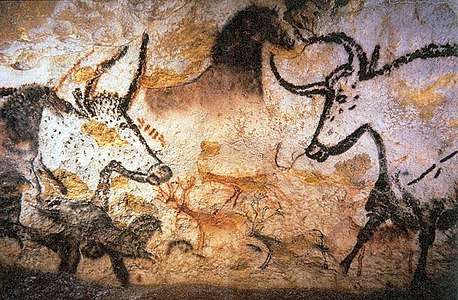
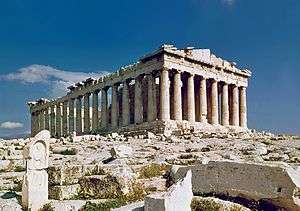
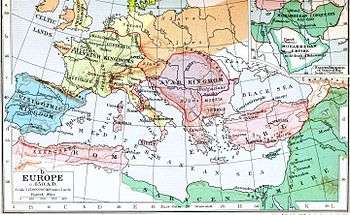
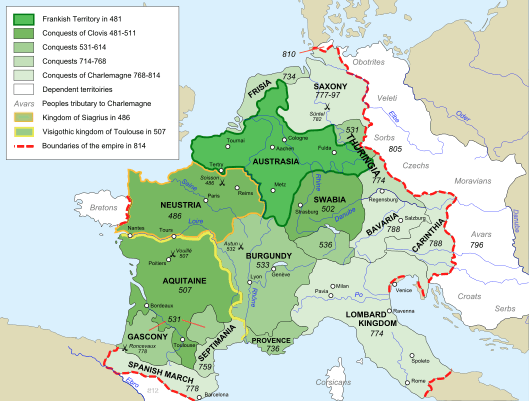
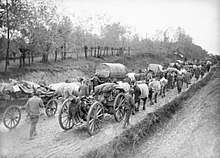

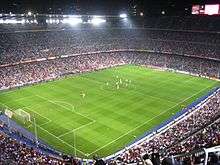
.svg.png)
.svg.png)
.svg.png)
.svg.png)
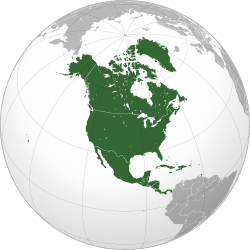
.svg.png)
_political.svg.png)
.svg.png)
.svg.png)
.svg.png)